Looking to invest in tech stocks in emerging markets but unsure where to start? This comprehensive guide covers everything you need to know: from understanding the unique growth drivers of emerging market technology sectors to identifying key subsectors like fintech, e-commerce, and semiconductors. Discover the best ways to access these markets through direct listings, ETFs, and private equity, while learning how to manage risks such as currency volatility, regulatory challenges, and political uncertainties. Whether you’re a beginner or an experienced investor, this article offers practical tips on valuation, portfolio construction, and trading strategies to help you confidently tap into the long-term growth potential of emerging market tech stocks. Start your journey to diversifying your portfolio with high-growth opportunities today.
Table of Contents:
- Introduction: Why Invest in Tech Stocks in Emerging Markets Now?
- The Macro and Market Backdrop for Emerging Market Tech:
- Big picture – growth with a few important caveats:
- Growth drivers that matter – users, mobile, cloud and AI:
- Capital flows and liquidity: where the money is, and where it is not?
- Macro risks you cannot ignore – inflation, rates and geopolitics:
- Concrete, action-oriented takeaways:
- Short checklist before you pull the trigger:
- Key Tech Themes and Subsectors to Watch:
- Artificial Intelligence and Machine Learning exposure:
- Semiconductors, hardware and global supply chains:
- Fintech, payments and digital financial services:
- E commerce, marketplaces and consumer internet:
- Enterprise software, cloud and SaaS adoption:
- Deep tech, quantum and emerging hardware plays:
- Quick cross-theme checklist: what I look at before I pull the trigger?
- Short, practical closing note:
- Regional and Country Spotlights: Where the Opportunities Live?
- China – Strategic Tech, Regulation, and How to Gain Access:
- India – Software Services, Startups, and Public Market Openings:
- Taiwan and South Korea – Semiconductor and Hardware Powerhouses:
- Southeast Asia – Mobile-First E-Commerce and Fintech Growth:
- Latin America – Digital Banks, Payments, and Proptech:
- Africa and Middle East – Fintech Leapfrogging and Connectivity:
- Frontier Markets – High Reward, Higher Risk:
- Final Thoughts:
- How to Access Emerging Market Tech Exposure:
- Direct Local Listings – Getting Close to the Action:
- American Depositary Receipts (ADRs) and Global Depositary Receipts (GDRs) – The Convenient Middle Ground:
- ETFs and Thematic Funds – Diversify Without the Headache:
- Mutual Funds and Active Management – The Human Edge:
- Private Markets – Getting In on the Ground Floor:
- Comparing Your Options – Liquidity, Costs, and Control:
- Final Thoughts:
- Valuation Frameworks and Financial Due Diligence:
- Risk Factors Specific to Emerging Market Tech:
- Regulatory and Data Privacy Risk, Including National Security Rules:
- Currency and FX Risk, Hedging Options and Tradeoffs:
- Political Risk, Capital Controls and Repatriation Issues:
- Corporate Governance, Related Party Transactions and Fraud Risk:
- Liquidity, Market Structure and Settlement Risk:
- ESG Risks and Stewardship Challenges in Emerging Markets:
- Putting It Together – Practical Risk Controls:
- Quick Checklist Before You Buy:
- Portfolio Construction and Position Management:
- Role of EM Tech in a Diversified Portfolio:
- Position Sizing, Concentration Limits and Risk Budgets:
- Rebalancing Rules, Stop Losses and Exit Criteria:
- Blending Thematic Bets with Core EM Exposure:
- Putting It Together – A Sample Playbook:
- Behavioral Notes: How to Avoid Common Mistakes?
- Final Practical Checklist:
- Trading, Execution and Tax Considerations:
- Trading Across Time Zones and Handling Thin Markets:
- Using ETFs for Tactical Exposure and Rebalancing Efficiency:
- Tax, Withholding and Reporting Issues for International Investors:
- Cost Management – Commissions, FX Spreads and Custody Fees:
- Short, Actionable Execution Checklist:
- Final note, from one trader to another:
- Practical Risk Mitigation Techniques:
- Currency Hedging Strategies and When to Use Them:
- Use of Derivatives, Options and Structured Products for Protection:
- Diversification Across Countries, Subsectors and Cap Sizes:
- Governance Screening and Third-Party Risk Checks:
- Putting It Together – A Simple, Practical Checklist:
- Final, Practical Tip (from someone who’s learned the hard way):
- Due Diligence Checklist: What to Verify Before You Buy?
- Quick orientation: how to use this checklist?
- Corporate Structure, Ownership and Related Parties:
- Financial Statements, Auditing Standards and Restatement Red Flags:
- Customer Base, Contracts and Revenue Concentration:
- Management Track Record, Insider Activity and Incentives:
- Legal, Regulatory and Compliance Review Steps:
- Final – A Practical Red-Flag Scoring Grid:
- Closing note, from the desk of someone who’s done the rounds:
- Case Studies and Lessons from Recent Market Events:
- Step by Step Action Plan for Investors and Traders:
- Quick framing: investor or trader?
- Step 1 – Research workflow and sources to follow:
- Step 2 – Screening for high-conviction opportunities:
- Step 3 – Deep-dive due diligence (before first meaningful buy):
- Step 4 – Execution plan: how to buy and size positions?
- Step 5 – Monitor positions and triggers that require reassessment:
- Quick practical checklists:
- Final, human advice:
- Conclusion – Long Term Opportunities, Practical Cautions and Next Steps:
- Frequently Asked Questions About Investing in EM Tech Stocks:
- Q1: Why should I consider tech stocks in emerging markets instead of just sticking with U.S. or European tech giants?
- Q2: Are emerging market tech stocks riskier than their developed market counterparts?
- Q3: How do I actually invest in emerging market tech stocks? Can I buy them directly?
- Q4: How important is currency risk, and should I hedge it?
- Q5: What sectors within emerging market tech should I focus on?
- Q6: How do I evaluate the quality of emerging market tech companies?
- Q7: What are some common pitfalls to avoid when investing in emerging market tech?
- Q8: How often should I review or rebalance my emerging market tech portfolio?
- Q9: Can beginner investors get started with emerging market tech stocks, or is it better left to experts?
- Q10: What resources or tools do you recommend for staying updated on emerging market tech?
Introduction: Why Invest in Tech Stocks in Emerging Markets Now?
If you think the only place to find exciting tech stories is Silicon Valley, think again: emerging markets are building their own fast-moving, locally driven tech ecosystems, and a handful of structural forces are making them worth a serious look right now. Mobile-first consumers, booming fintech adoption, the AI funding wave, and renewed capital flows are all creating fresh opportunities, while geopolitical and regulatory shifts are reshaping where and how value is captured. The result is higher potential growth, more concentrated winners, and also heavier volatility; that mix is exactly why disciplined investors are paying attention.
Global macro growth is not bulletproof, and that matters. Major institutions expect modest, uneven growth across emerging market economies in 2025, with downside risks from trade tensions, weaker global trade, and policy uncertainty. Put simply: the runway for growth exists, but it comes with geopolitical and macro headwinds that can make short-term returns bumpy. This section and the rest of the guide are meant to help you find the signal in that noise.
Why the interest now? Three practical dynamics are worth highlighting:
- first, consumer and financial services adoption is surging in many regions: mobile money and digital payment systems alone show explosive user gains that translate into addressable markets for fintech and commerce platforms.
- Second, venture and growth capital is back in the picture, especially around AI and platform plays, which fuels public-market IPOs and faster scale-ups.
- Third, investor tools are improving: thematic ETFs, active EM tech funds, and cross-listings make it easier to get targeted exposure without single-stock concentration if you prefer that route.
These are not hypothetical trends, they are measurable shifts shaping deal flow and valuations across EM tech.
That said, structure matters. Manufacturing and hardware champions in parts of Asia, notably semiconductors and related supply chains, remain central to global tech, while regions such as Latin America and Africa are winning with platform-led fintech and e-commerce that leapfrog legacy systems. These differences mean your playbook should change by region, and even by subsector: the risks, the growth drivers, and the path to profitability look different from what you see in mature markets.
Finally, a note of realism. Regulation, data rules, and geopolitical friction can wipe out paper gains quickly, and access or listing structures vary widely from one market to another. China’s evolving data and cross-border rules, for example, have been a major consideration for investors assessing tech exposure, and changes in global trade or industrial policy can rapidly shift the competitive map. That kind of risk does not mean “don’t invest,” it means do the homework, size positions carefully, and use the right access route for your goals.
Read on and you will get a practical map: why the opportunity is real, where it is concentrated, and how to approach research, access, valuation, and risk management so you can capture upside without getting surprised. Consider this a friendly but frank briefing: we will celebrate the tailwinds, and we will plan for the headwinds.
What Makes Emerging Market Tech Different from Developed Market Tech:
Emerging market tech tends to be mobile-first, adoption-driven, and often solves local frictions rather than duplicating Western product sets. Unit economics, pricing power, and customer behavior can look very different: companies may scale faster in users, but take longer to translate that into consistent profits.
Market structure also differs: a handful of national or regional champions often dominate their category, regulations can be more interventionist, and capital markets may be shallower, which amplifies price moves. That combination explains why EM tech offers asymmetric return potential, and also why active, region-aware research matters more than a passive copy of a US tech playbook.
Who This Guide Is For and How to Use It:
This guide is for curious investors and traders who want to add smart, intentional exposure to tech-led growth outside the developed world.
- If you are a long-term investor, use the guide to build durable positions and a monitoring checklist.
- If you are a trader, use the sections on liquidity, access routes, and execution to avoid nasty surprises.
- If you are brand new to EM investing, follow the step-by-step due diligence checklist and treat early trades as learning positions rather than bets you need to win on day one.
The rest of the article breaks things down into practical, repeatable steps: how to find ideas, how to access them, how to size positions, and how to protect yourself when markets get choppy.
The Macro and Market Backdrop for Emerging Market Tech:
If emerging market tech were a party, it would feel like a mix of celebration and caution: lots of interesting guests, rapid conversations about the future, and the occasional power cut when the electricity grid decides to remind you which country you are in.
That contrast is the lens investors need: structural growth and deep addressable markets on one hand, and macro and political friction on the other. Put another way, the upside here can be very real, but so can the sudden price swings; the trick is to treat opportunity and risk as two sides of the same trade.
Big picture – growth with a few important caveats:
Global growth is choppy but not collapsing, and emerging market growth is expected to remain a meaningful part of the global expansion story. Official forecasts show modest, uneven growth for the world economy in the near term, with emerging and developing economies still punching above the global average in many scenarios. That helps explain why many investors are willing to look beyond developed markets for faster revenue trajectories and earlier-stage technology adoption.
At the same time, inbound investment into developing countries is not racing ahead: foreign direct investment fell in recent years, reflecting tighter global financing conditions and a more cautious appetite for big cross-border projects. That means startups and public companies in many emerging markets may face tougher funding cycles, and when external capital retreats their valuations and liquidity can move quickly.
Growth drivers that matter – users, mobile, cloud and AI:
Three concrete forces explain most of the long-term upside in EM tech:
- Users arriving at scale: hundreds of millions of people are coming online for the first time, and many of them are mobile-first. That creates enormous addressable markets for payments, commerce, entertainment, and local services, and user growth here is often faster than in saturated developed markets. The mobile infrastructure data shows a steady increase in smartphone and mobile internet penetration across many developing regions, which is the plumbing that makes scale possible.
- Cloud-native strategies and lower fixed costs: cloud services let founders build globally competitive products without huge capital expenditure, which shortens the path from prototype to scale. That matters because it allows local startups to concentrate on product market fit and unit economics rather than on building data centers first.
- AI as an accelerator: AI, especially in the last year, has sucked up a lot of venture capital and innovation oxygen, and emerging market founders are leveraging off-the-shelf models to localize offerings quickly. That creates pockets of fast-moving innovation, where clever teams convert modest capital into outsized local market advantages. Recent VC and AI funding trends show record deal activity in AI, which is an engine for both private and eventual public-market growth.
Practical investor note: when you hear big user numbers, ask two follow-up questions: how many of those users are active and monetizable, and what is the cost to acquire and keep them. Scale without unit economics is an attention-grabbing headline, but it is not an investable business for long.
Capital flows and liquidity: where the money is, and where it is not?
Money flows determine how easily you can enter and exit positions, and they shape valuations. The picture is mixed right now:
- Private capital remains active in high-conviction themes like fintech and AI; founders with clear monetization routes continue to attract rounds. That keeps a private pipeline of potential public-market winners alive.
- Public market liquidity can be episodic: ETF flows, index moves, and large cross-border investors can all swing in or out of emerging-market tech quickly. This makes single-stock positions in smaller markets inherently less forgiving.
- Industry and policy moves are expanding access in some places: for example, listing reforms in major regional hubs are designed to attract tech IPOs, which can widen the route to liquidity for founders and early backers. These policy changes can open windows of opportunity for companies that previously had little access to deep public capital markets.
Practical investor note: if you plan to hold an EM tech stock through volatility, check where it is listed, whether it has cross-listings, and the average daily turnover. Those things determine how easy it is to scale positions and how big a price move you might endure when the market gets nervous.
Macro risks you cannot ignore – inflation, rates and geopolitics:
Three macro levers mostly drive short-term pain in EM tech:
- Inflation and policy rates: many emerging economies still face higher and more variable inflation than advanced economies. Higher local interest rates raise discount rates for growth stocks, increase borrowing costs for startups, and can choke off consumer credit growth that fintech firms rely on. Model your valuations with realistic, higher discount rates for these regions.
- Currency swings and external funding: when risk appetite falls, currencies can weaken quickly. That makes any foreign-currency debt more painful and can raise costs for firms that import hardware or cloud services billed in dollars. For investors, currency moves can double or halve returns, depending on your exposure and hedging choices.
- Trade and technology policy shocks: export controls, tariffs, or sudden regulatory limits can change a company’s addressable market overnight. This is especially true for semiconductor and hardware supply chains, and increasingly relevant for firms dependent on AI hardware or cross-border data flows.
Practical investor note: treat each company’s exposure to rates, currency, and policy as a first-class input in your model; the story alone is not enough, you need scenario-based stress tests.
Concrete, action-oriented takeaways:
- Match instrument to intent: want pure growth, and can survive volatility? Consider carefully selected local large-cap tech names and high-conviction SMEs; want smoother exposure? Use ETFs or regional funds.
- Size for surprise: in EM tech, position sizing matters more than perfect timing; cap stakes so you can ride through macro noise without being forced to sell.
- Research locally, think globally: local user metrics, regulatory filings, and payment flows often tell the true story; pair them with macro screens like policy rate trajectories and FDI trends.
- Stress-test the downside: run scenarios for higher rates, a 15 to 30 percent currency decline, and a regional regulatory tightening, then ask whether you would still own the stock.
Short checklist before you pull the trigger:
- Where is the company listed, and how liquid is the market?
- Are revenues local-currency or dollar linked, and does the company have foreign-currency debt?
- Is user growth translating into improving unit economics?
- How likely is the company to be affected by an export control or regulatory shock?
- Do you have an exit plan if liquidity dries up?
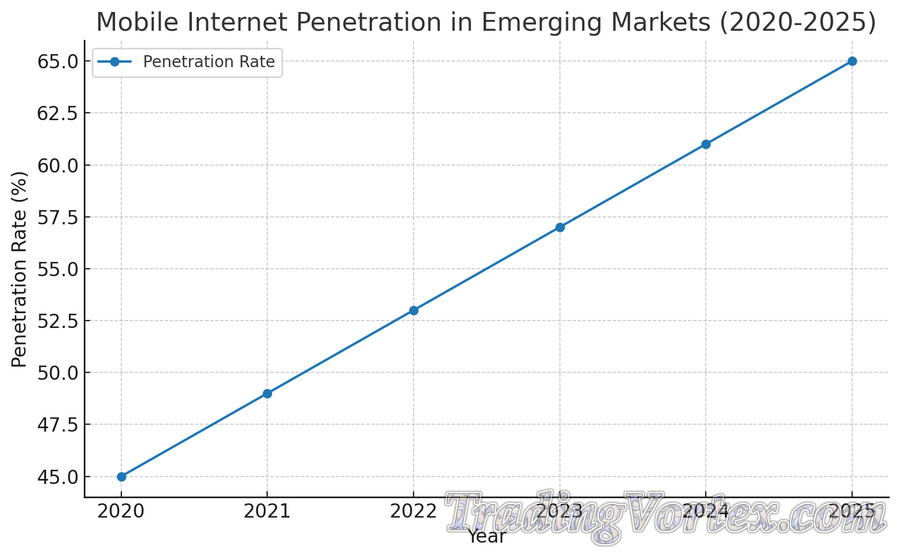 Mobile Internet Penetration across Emerging Markets from 2020 to 2025: The chart illustrates the steady rise in mobile internet penetration across emerging markets from 2020 to 2025. Starting at 45 percent in 2020, penetration has grown each year, reaching a projected 65 percent in 2025. This growth reflects wider smartphone adoption, improved network infrastructure, and the shift toward mobile-first economies in regions such as Asia, Africa, and Latin America. For investors, this expanding digital access underpins the addressable market for fintech, e-commerce, cloud services, and AI-driven applications, making it a key macro driver behind the growth of emerging market tech stocks.
Mobile Internet Penetration across Emerging Markets from 2020 to 2025: The chart illustrates the steady rise in mobile internet penetration across emerging markets from 2020 to 2025. Starting at 45 percent in 2020, penetration has grown each year, reaching a projected 65 percent in 2025. This growth reflects wider smartphone adoption, improved network infrastructure, and the shift toward mobile-first economies in regions such as Asia, Africa, and Latin America. For investors, this expanding digital access underpins the addressable market for fintech, e-commerce, cloud services, and AI-driven applications, making it a key macro driver behind the growth of emerging market tech stocks.
Key Tech Themes and Subsectors to Watch:
Artificial Intelligence and Machine Learning exposure:
Investor signals to watch: revenue/ARPU uplift from AI features, improvements in customer retention after AI rollouts, partnerships with cloud providers or model vendors, and evidence of defensible data moats that improve models over time.
Risks: compute is expensive, latency matters, and export controls on advanced AI chips can affect access to best-in-class hardware for some firms. Also, hype can inflate multiples before real monetization arrives.
Practical tip: favor companies that show measurable incremental revenue from AI features, not just flashy demos; and check whether their cloud and compute arrangements are scalable without huge capex surprises.
Semiconductors, hardware and global supply chains:
Investor signals to watch: new fab announcements or government incentive packages, order books for advanced packaging, reported wafer capacity trends, and customer concentration among large cloud or AI buyers. Watch also for policy moves that affect tool makers or chip exports.
Risks: export controls, IP leakage, long capex cycles, and single-site production risks. For traders, liquidity matters: many semiconductor-related EM names are small caps with thin trading volumes, so execution and exit planning are essential.
Practical tip: prefer companies with clear customer contracts or foundry relationships, and stress-test valuations for longer capex payback and sudden tariff or export-control shocks.
Fintech, payments and digital financial services:
Investor signals to watch: take rate trends, e money float economics, customer acquisition cost versus lifetime value, regulatory clarity on lending and deposit taking, and central bank initiatives that can widen adoption (for example, recurring payments added to instant-pay systems). Recent policy and product moves have materially expanded addressable volumes in markets such as Brazil and parts of Africa.
Risks: regulatory changes, interest-rate sensitivity for lending products, and FX exposure where lenders or platforms use foreign capital. Also be mindful of concentration in a single national market; leadership there can be huge, but so can national policy risk.
Practical tip: when valuing fintechs, model both transaction volume growth and the margin on transactions or financial products, and include scenarios for consumer credit cycles and local rate shocks.
E commerce, marketplaces and consumer internet:
Investor signals to watch: gross merchandise value (GMV) growth, take rates, contribution margin per order, logistics cost per order trends, and evidence of improved monetization such as advertising or financial services tie-ins.
Risks: competition remains fierce, unit economics can be fragile until scale, and macro slowdowns compress discretionary spending. Platform governance and marketplace trust metrics are also important for long-term retention.
Practical tip: prioritize platforms showing improving contribution margins and diversified monetization, or niche marketplace leaders with defensible supply-side moats.
Enterprise software, cloud and SaaS adoption:
Investor signals to watch: ARR growth and net retention for SaaS names, customer concentration among verticals, cloud spend as a percentage of revenue for scaling startups, and partnerships or reseller agreements with large cloud providers.
Risks: churn and slow sales cycles among enterprises, localized competition with free or cheaper substitutes, and FX exposure for companies that bill in local currency but use dollar-denominated cloud services.
Practical tip: for EM SaaS, focus on vertical SaaS with strong customer stickiness, predictable recurring revenue, and an expanding wallet share in defined industries.
Deep tech, quantum and emerging hardware plays:
Risks: long time horizons, capital intensity, and high technical risk; this is a domain where patient capital or niche allocators tend to outperform generalist public-market investors.
Practical tip: treat deep tech as a diversification sleeve: allocate only what you can afford to lock up for multiple years, and prefer funds or specialized public vehicles that have domain expertise.
Quick cross-theme checklist: what I look at before I pull the trigger?
- User and monetization metrics: active users, ARPU, take rate, net revenue retention.
- Unit economics: contribution margin, payback period on CAC, and path to profitability.
- Liquidity and listing venue: average daily volume, cross-listings, and ETF coverage if you need easier exits.
- Policy exposure: export controls, data rules, and national payment-system changes.
- Funding and capital access: recent rounds, debt vs equity mix, and local funding climate.
Short, practical closing note:
Each theme offers a different route to exposure: some are structural and long duration, like cloud and fintech infrastructure; others are cyclical and policy-sensitive, like semiconductors. The smart play is to match the instrument to the story and the time horizon, size thoughtfully, and watch the handful of KPIs that matter for each subsector.
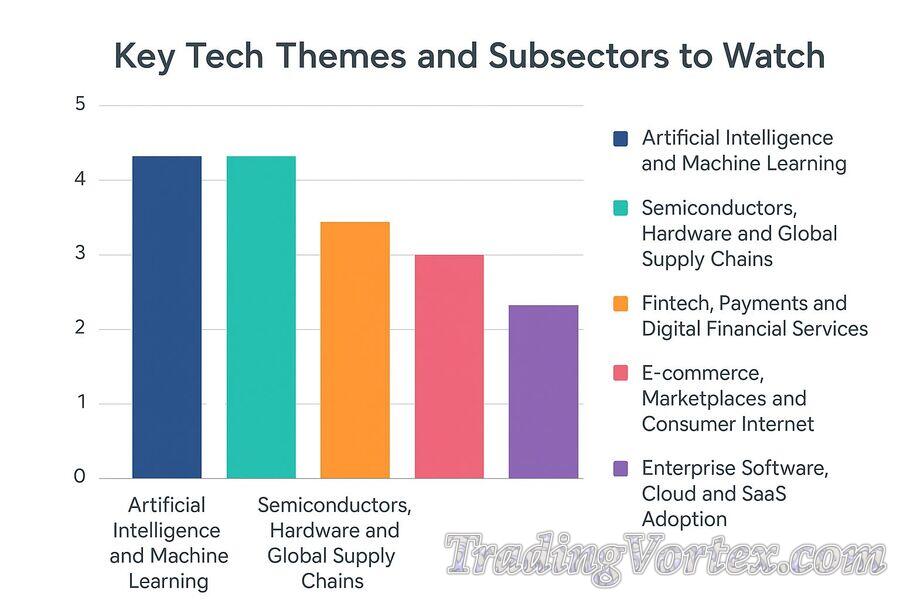
Regional and Country Spotlights: Where the Opportunities Live?
Investing in tech stocks across emerging markets is like embarking on an exciting global adventure. Each region has its own story to tell, offering a mix of unique growth drivers, distinct challenges, and varying degrees of market maturity. Whether you’re a cautious beginner or a seasoned pro, understanding these regional nuances is crucial to making smart investments that align with your goals and risk tolerance. Let’s dive into the hottest tech hubs and what makes them tick in 2025.
China – Strategic Tech, Regulation, and How to Gain Access:
China remains a colossal player in emerging-market tech, powering everything from AI advancements to semiconductor manufacturing. However, investing in Chinese tech stocks requires more than just enthusiasm; it demands a savvy understanding of an evolving regulatory environment.
In 2025, the government continues to actively shape the industry through policies aimed at consolidating strategic sectors like semiconductors and AI into state-backed champions. This approach offers some companies deeper pockets and long-term support, but also brings political risk that can quickly affect valuations.
For investors, access to Chinese tech firms isn’t straightforward. You can explore A-shares on mainland exchanges, companies listed in Hong Kong, or American Depositary Receipts (ADRs) on U.S. markets. Each path has its quirks — varying liquidity, currency risk, and regulatory oversight — so it pays to diversify how you gain exposure.
If you want to play China’s tech game well, watch for firms that benefit from Beijing’s “new infrastructure” initiatives, like 5G networks and AI labs, but stay alert for any regulatory surprises that might upend short-term momentum.
India – Software Services, Startups, and Public Market Openings:
India’s tech scene is buzzing with energy. Beyond the well-known software service giants, the real fireworks are happening in startups focused on fintech, e-commerce, edtech, and cloud services.
The Indian IPO market has been impressively resilient in early 2025, with over 100 new listings raising $4.6 billion. This momentum reflects a growing maturity in the public markets, giving investors a wider range of options to join the party.
Foreign investors usually gain access through local exchanges or ADRs, though sector-specific ownership limits exist. A bright spot is the growing prominence of hubs like Gujarat International Finance Tec-City (GIFT City), which is making it easier for global capital to flow into Indian startups.
If you’re eyeing India, look for companies with scalable business models, improving profitability, and strong digital adoption, which tend to outperform in this dynamic market.
Taiwan and South Korea – Semiconductor and Hardware Powerhouses:
When it comes to semiconductors and hardware, Taiwan and South Korea are the undisputed champions. Taiwan’s chip foundries and South Korea’s memory manufacturers sit at the heart of the global tech supply chain, powering everything from smartphones to AI data centers.
In 2024, Taiwan’s semiconductor output surged by 22%, signaling continued robust demand. But it’s not all smooth sailing: these countries face cyclical industry slumps and geopolitical tensions that can shake markets.
Investors can find relatively liquid opportunities through local exchanges or ADRs, though it’s important to watch for macro risks like export restrictions and supply chain disruptions.
If you want to ride this wave, focus on companies with strong customer contracts, diversified product lines, and exposure to cutting-edge chip technologies.
Southeast Asia – Mobile-First E-Commerce and Fintech Growth:
Southeast Asia is where the phrase “mobile-first” truly comes to life. Countries like Indonesia, Vietnam, and the Philippines are embracing e-commerce and fintech with a passion, thanks to rising smartphone use and a large population of underbanked consumers.
E-commerce sales in the region are expected to more than double to $410 billion by 2030, creating fertile ground for platform businesses and payment innovations. Fintech startups are similarly thriving, offering digital wallets, peer-to-peer lending, and other financial services that leapfrog traditional banking.
Access for foreign investors can be tricky, with many companies still private or listed on less-liquid local exchanges. Regional ETFs and cross-listings on Singapore or Hong Kong exchanges can offer a practical workaround.
Staying informed about local regulations, digital banking licenses, and payment interoperability will help you spot sustainable winners.
Latin America – Digital Banks, Payments, and Proptech:
Latin America is making rapid strides in digital finance, with countries like Brazil and Mexico leading the charge. Digital payments now account for around 60% of consumer spending, and innovative digital banks are reaching underserved populations at scale.
Beyond finance, proptech startups are modernizing real estate markets that have traditionally been slow to digitize, adding another layer of opportunity.
Liquidity and access vary, with most investments funneled through local exchanges or ADRs. Currency fluctuations and political changes can be challenging, but firms that localize products and diversify revenue streams tend to be more resilient.
If you’re investing here, emphasize understanding the economic and regulatory backdrop alongside company fundamentals.
Africa and Middle East – Fintech Leapfrogging and Connectivity:
The digital revolution is well underway in Africa and the Middle East, especially in fintech and infrastructure. Africa’s mobile money platforms, like M-Pesa, are classic examples of leapfrogging outdated financial systems and bringing millions into the digital economy.
Digital lending, Buy Now Pay Later (BNPL) options, and open finance regulations are shaping a vibrant ecosystem. In the Middle East, digital banking markets are projected to nearly double in size over the next few years.
Most opportunities are in private companies or frontier market funds, but infrastructure investments in broadband and data centers are creating a solid foundation for future tech growth. Political and economic stability remain important factors to weigh carefully.
Frontier Markets – High Reward, Higher Risk:
If you have a taste for adventure and can stomach volatility, frontier markets offer some of the highest-risk, highest-reward opportunities. These include parts of Eastern Europe, Central Asia, and smaller African nations where tech adoption is nascent but accelerating.
Venture capital investment in frontier technology jumped nearly 50% year-over-year, with a particular focus on AI, defense tech, and industrial automation.
Investing here demands local knowledge, patience, and a hands-on approach. You’ll want to vet deals thoroughly and prepare for illiquid markets and regulatory surprises.
Final Thoughts:
By taking a regional approach and balancing growth potential with risk, you can position yourself to catch some of the fastest-growing tech stories on the planet, often before they hit mainstream headlines.

How to Access Emerging Market Tech Exposure:
Diving into emerging market tech stocks can sometimes feel like stepping into a bustling global bazaar. There are countless paths to explore, each offering unique opportunities but also distinct challenges. Whether you want to get your hands dirty trading local shares or prefer the ease of ETFs, knowing your options and the pros and cons of each can make all the difference.
Let’s walk through the most common ways to access this exciting space, so you can build a portfolio that suits your style and goals.
Direct Local Listings – Getting Close to the Action:
Buying shares directly on local exchanges in emerging markets is the most straightforward way to own a piece of these companies. You get full exposure to local tech stars exactly where they operate.
Why consider direct listings?
- Authenticity: You’re investing on the home turf of the companies driving innovation.
- Potential bargains: Sometimes local stocks trade at a discount compared to their foreign-listed peers.
- Currency dividends: Earnings paid in local currency can add a diversification layer.
What to watch out for:
- Liquidity: Smaller exchanges or lesser-known tech firms may have thin trading volumes, making it harder to buy or sell quickly.
- Regulatory and political risks: Emerging markets can have unpredictable regulatory environments and political shifts.
- Currency risk: Fluctuations in exchange rates can impact your returns; some brokers do not offer currency hedging, so factor that in.
Tips to get started:
- Find a brokerage platform that supports international trading in markets like India’s NSE, Brazil’s B3, or South Africa’s JSE.
- Start small and focus on large-cap, well-known tech firms as you build familiarity.
- Keep an eye on tax implications and settlement rules specific to each market.
American Depositary Receipts (ADRs) and Global Depositary Receipts (GDRs) – The Convenient Middle Ground:
If trading on foreign exchanges feels overwhelming, ADRs and GDRs offer a simpler path. These are certificates traded on major global exchanges representing shares in foreign companies.
Benefits:
- Ease of access: No need for foreign brokerage accounts or currency conversions.
- Higher liquidity: Usually traded on U.S. or European markets with more volume.
- Transparency: Reporting and regulatory standards are often more familiar to international investors.
Limitations:
- Limited universe: Not all companies issue ADRs or GDRs, so your choice is narrower.
- Fees and taxes: There may be additional fees and dividend withholding taxes compared to direct shares.
- Price deviations: Occasionally, ADR prices can diverge from their underlying shares due to market demand.
ETFs and Thematic Funds – Diversify Without the Headache:
For investors who prefer a more hands-off, diversified approach, Exchange-Traded Funds (ETFs) and thematic mutual funds focused on emerging market tech are highly appealing.
Why ETFs and funds are popular:
- Instant diversification: Exposure to dozens or even hundreds of tech companies across multiple countries.
- Liquidity: ETFs trade like stocks, so you can buy or sell easily during market hours.
- Cost-effectiveness: Usually, expense ratios range between 0.3% and 0.7%, which is affordable for many investors.
- Thematic focus: You can find funds centered on fintech, e-commerce, cloud computing, or broader emerging tech sectors.
Points to consider:
- Tracking error: Funds may not perfectly mirror the underlying index performance.
- Expense ratios: While generally low, fees do eat into your returns over time.
- Fund structure: Understand whether the ETF physically holds shares or uses derivatives, as this affects risk and performance.
Mutual Funds and Active Management – The Human Edge:
If you appreciate expertise and active decision-making, mutual funds and specialist strategies can provide tailored exposure to emerging market tech.
Advantages:
- Professional insight: Managers can dig deeper, navigating geopolitical and regulatory challenges.
- Flexibility: Active funds can adjust holdings quickly in response to market changes.
- Specialization: Some managers focus exclusively on emerging market tech or key subsectors like semiconductors or AI.
Considerations:
- Higher fees: Annual expense ratios often exceed 1%, reflecting management expertise.
- Performance variability: Not every manager beats the benchmark, so thorough due diligence is key.
- Transparency: Holdings may not be disclosed daily as ETFs do.
Private Markets – Getting In on the Ground Floor:
For investors with patience, a higher risk appetite, and sufficient capital, private market investments offer a chance to participate in emerging market tech startups and growth companies before they go public.
What you get:
- Early access: Invest in disruptive companies during their high-growth phases.
- Potential for outsized returns: Private firms that succeed can generate significant wealth.
- Closer involvement: Some investors enjoy direct relationships with founders and management.
What to be cautious about:
- Illiquidity: Your capital might be locked up for years.
- Higher risk: Startups have higher failure rates than established companies.
- High minimums and fees: Private equity funds often require large commitments and charge management plus performance fees.
Comparing Your Options – Liquidity, Costs, and Control:
Choosing the right access method comes down to balancing key factors:
| Access Method | Liquidity | Fees | Control & Transparency | Best For |
|---|---|---|---|---|
| Direct Local Listings | Variable, often low | Lowest (trading fees) | High, direct ownership | Experienced investors wanting full exposure |
| ADRs/GDRs | Moderate to high | Low to moderate | Medium, proxy ownership | Those seeking convenience and liquidity |
| ETFs/Thematic Funds | High | Moderate (0.3-0.7%) | High transparency | Passive investors seeking broad exposure |
| Active Mutual Funds | High | Higher (1%+) | Depends on manager | Investors valuing expertise and flexibility |
| Private Markets | Low | Highest (2%+ plus carry) | Low, illiquid assets | Sophisticated investors with long horizons |
Final Thoughts:
The secret lies in blending these approaches to balance liquidity, fees, risk, and control, while staying alert to the evolving regulatory and geopolitical landscapes. Remember, investing in emerging markets is a journey with ups and downs; but it also offers some of the most exciting growth stories in the global economy.
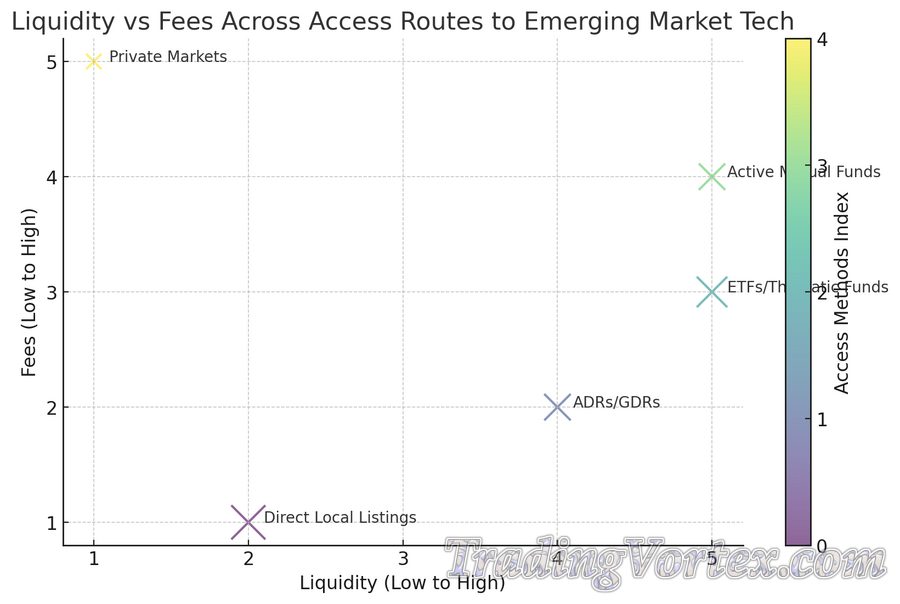 Liquidity vs Fees Across Access Routes: This scatter plot shows how different investment methods compare in terms of liquidity and fees. The bubble size reflects the degree of control and transparency you get. You can see that direct local listings offer high control but lower liquidity, while ETFs provide high liquidity with moderate fees.
Liquidity vs Fees Across Access Routes: This scatter plot shows how different investment methods compare in terms of liquidity and fees. The bubble size reflects the degree of control and transparency you get. You can see that direct local listings offer high control but lower liquidity, while ETFs provide high liquidity with moderate fees.
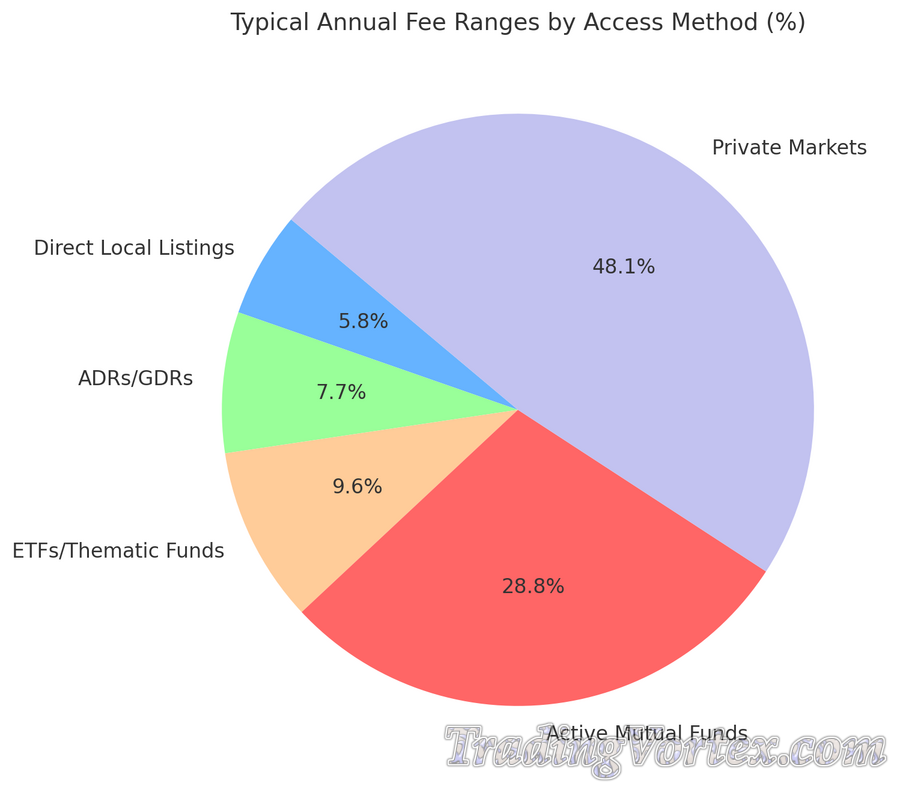 Typical Annual Fee Ranges by Access Method: This pie chart breaks down typical fee percentages, highlighting how fees tend to rise as you move from direct local listings up to private market investments, which carry the highest costs due to complexity and illiquidity.
Typical Annual Fee Ranges by Access Method: This pie chart breaks down typical fee percentages, highlighting how fees tend to rise as you move from direct local listings up to private market investments, which carry the highest costs due to complexity and illiquidity.
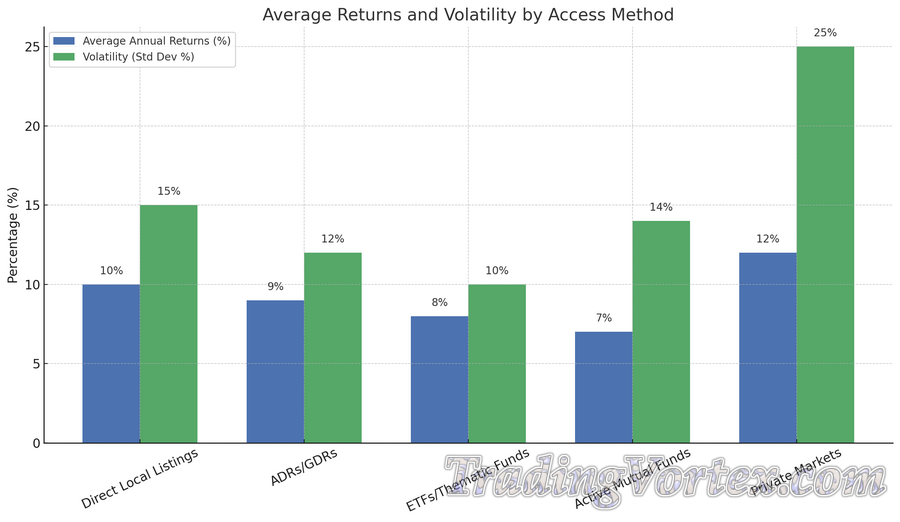 Average Returns and Volatility by Access Method: This bar chart presents hypothetical average annual returns alongside volatility for each access route. Private markets have the highest potential returns but come with the greatest risk and illiquidity, while ETFs and ADRs offer a more balanced risk-return profile.
Average Returns and Volatility by Access Method: This bar chart presents hypothetical average annual returns alongside volatility for each access route. Private markets have the highest potential returns but come with the greatest risk and illiquidity, while ETFs and ADRs offer a more balanced risk-return profile.
Valuation Frameworks and Financial Due Diligence:
Investing in emerging market tech stocks is often like trying to read a novel in a foreign language: there’s a lot of exciting story, but some of the nuances can get lost or misunderstood. Valuing these companies and doing proper financial due diligence requires more than just plugging numbers into a spreadsheet. You need to think critically, adapt traditional frameworks, and approach every company with a healthy dose of curiosity and skepticism.
In this section, we’ll break down how to get that valuation right, focusing on the special twists that emerging markets bring to the table.
Adjusting Valuation Models for Country Risk and Currency Effects:
Here’s the reality: emerging markets come with additional layers of risk that don’t usually show up in your average tech stock from the U.S. or Europe. Political uncertainty, currency volatility, and economic instability can significantly affect company valuations, and ignoring these factors can lead to nasty surprises.
- Country Risk Premium: Think of this as a surcharge you add on top of your expected returns to compensate for the unpredictability of local politics, policy shifts, or social unrest. For example, a tech firm in Indonesia may carry a higher country risk premium than one in South Korea due to differences in regulatory environment or political stability. Typically, investors add anywhere from 2% up to 7% on their discount rate depending on the country’s risk profile.
- Currency Fluctuations: Currency swings can have a double-edged effect. If you hold stocks priced in a local currency that weakens against your home currency, your returns suffer even if the company’s fundamentals remain solid. On the other hand, currency strength can amplify gains. When modeling valuations, it’s wise to run your cash flows in local currency and then apply realistic exchange rate assumptions or hedge costs if available.
- Inflation and Interest Rates: Many emerging markets grapple with higher inflation and interest rates, which can erode real profits and increase capital costs. Make sure your valuation models factor in these economic conditions either through adjusted discount rates or more conservative growth forecasts.
Adapting your valuation models to these realities is like tuning your car for a bumpy road: you want to be prepared for the twists and turns ahead.
Revenue Quality, Margins, and Unit Economics in EM Tech Firms:
The surface-level financials might look shiny, but it’s the quality beneath that counts most.
- Revenue Sustainability: Fast-growing top-line numbers can be alluring, but ask yourself: Is the revenue recurring or one-off? Does the company depend heavily on government contracts or a small number of clients? Emerging market firms sometimes rely on non-recurring revenues or subsidies, which can distort the growth picture.
- Profit Margins: Margins in emerging market tech can be all over the place. Some startups are intentionally running losses to capture market share: think of it as paying to play. Others benefit from government incentives or cheaper labor costs, which can inflate margins temporarily. Look at trends in gross and operating margins to assess if profitability is improving sustainably.
- Unit Economics: This is where the rubber meets the road. How much does it cost to acquire and serve each customer, and how much revenue and profit does each customer generate over time? For example, fintech firms in emerging markets might have lower customer acquisition costs due to less saturated markets, but increasing competition can rapidly change that dynamic. Tracking metrics like Customer Lifetime Value (CLV) versus Customer Acquisition Cost (CAC) can provide a clearer picture of business viability.
I like to think of this as being a financial detective: digging past the headlines and finding the real clues.
Comparable Company Analysis and Regional Multiples:
Using multiples is a fast and intuitive way to value companies, but in emerging markets, context is king.
- Finding True Peers: Comparing an Indian SaaS firm to a Silicon Valley unicorn just won’t work. Instead, seek out companies operating in similar regulatory and economic environments or those serving comparable markets.
- Regional Valuation Trends: Emerging markets don’t have a unified multiple range. For instance, South Korea and Taiwan, with mature capital markets and tech ecosystems, tend to command higher valuations than frontier markets like Nigeria or Vietnam. It’s also important to adjust multiples for differences in growth rates and profitability.
- Market Sentiment and Liquidity: Sometimes valuations reflect investor sentiment more than fundamentals. Tech stocks in emerging markets may trade at a premium during hype cycles or at a discount during sell-offs due to liquidity constraints.
Multiples are helpful but remember to always read the fine print and understand what’s driving the numbers.
Scenario and Sensitivity Analysis for Regulatory Shocks:
Regulatory risk in emerging markets is real and often unpredictable. New data privacy laws, changes in foreign ownership rules, or sudden tax reforms can reshape a company’s outlook overnight.
- Scenario Planning: Build a range of cases to understand potential outcomes. For example, what if a new fintech regulation caps fees? Or a government imposes restrictions on foreign investors? How will these changes affect revenues and margins?
- Sensitivity Checks: Tweak key assumptions like discount rates, growth rates, and margin projections to see how sensitive your valuation is to changes. If small adjustments cause huge swings in value, that’s a sign to proceed cautiously.
- Continuous Monitoring: Regulatory landscapes in emerging markets evolve quickly. Staying connected with local experts, following news closely, and updating your assumptions regularly is essential to avoid nasty surprises.
Think of this like packing for a trip with unpredictable weather: you want to be prepared for sunny skies and sudden storms.
Final Thoughts:
Remember, investing here is a marathon, not a sprint. Patience, flexibility, and a keen eye will serve you well on this journey.
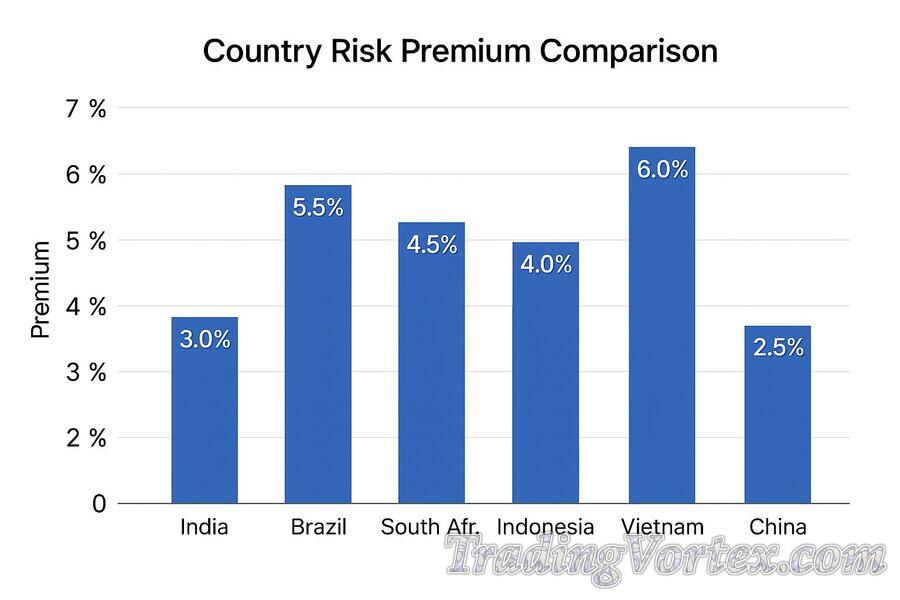
Risk Factors Specific to Emerging Market Tech:
Investing in emerging market tech is exciting, often profitable, and sometimes a little merciless. The rewards can be big, but the risk profile is different from what you see in developed markets: regulatory surprises, currency swings, governance gaps, thin liquidity, and ESG tail risks all show up with greater frequency and force. Below I walk through the top risks you will face, explain why they matter, and give practical, no-nonsense ways to think about them when you are sizing positions or running due diligence.
Regulatory and Data Privacy Risk, Including National Security Rules:
What to watch for: national data protection laws and enforcement actions, guidance on data transfers from major regulators, and sector-specific restrictions that affect fintech, cloud, or AI firms. For example, China’s layered framework of the Personal Information Protection Law, Data Security Law, and Cybersecurity Law creates a complex compliance environment for tech firms, and regulators across jurisdictions are updating guidance on transfers to third-country authorities.
Practical take: build a regulatory checklist for each company you own: where data is stored, what cross-border transfers exist, critical licenses, and how quickly compliance costs could scale.
Currency and FX Risk, Hedging Options and Tradeoffs:
What to watch for: recent FX volatility trends, companies’ currency mix for revenues and debt, and central bank policy trajectories. Hedging is available, but it is not free; hedging costs, imperfect instruments, and the potential for hedge mismatches can erode returns. The IMF and other bodies have highlighted how interest-rate moves and global volatility keep FX risks prominent for EM investors.
Practical take: model returns in both local currency and your home currency; where practical, prefer companies with natural FX hedges, dollar revenues, or low foreign-currency debt. For portfolio-level exposure, consider selective hedging when FX risk materially changes your downside.
Political Risk, Capital Controls and Repatriation Issues:
What to watch for: local and regional political stability indicators, recent history of capital controls or FX market intervention, and government rhetoric about foreign investment. Country investment climate reports and official notices are good sources to monitor.
Practical take: treat repatriation risk as a liquidity and legal risk: diversify country exposures, prefer firms with multiple listing venues or ADRs where repatriation risk is lower, and keep an emergency exit plan.
Corporate Governance, Related Party Transactions and Fraud Risk:
What to watch for: shareholder structure, related-party transactions, audit quality, frequent auditor changes, and red flags in accounting notes. Recent cases that grabbed headlines underscore this risk and the importance of forensic-style checks in due diligence.
Practical take: dig into ownership charts, read audit reports and related-party schedules, and monitor unusual cashflow patterns. If you cannot get clear answers, reduce position size or stay away. Real-world governance failures in the last few years make this a must-check item.
Liquidity, Market Structure and Settlement Risk:
What to watch for: average daily turnover, bid-ask spreads, cross-listing status, and whether local settlement systems have recent operational issues. ETF flows into and out of EM can also amplify liquidity squeezes, since passive products can hasten moves in and out of whole buckets of stocks.
Practical take: prefer names with reasonable daily volume or cross-listings, use limit orders when trading small-cap EM names, and size positions to account for potential slippage. Monitor ETF flows as a macro liquidity signal.
ESG Risks and Stewardship Challenges in Emerging Markets:
What to watch for: gaps in public ESG disclosures, local regulatory expectations for sustainability, and major environmental or social issues tied to business models. International development institutions and multilaterals are actively improving ESG reporting frameworks in EM, which can raise standards but also reveal new liabilities.
Practical take: use third-party ESG frameworks and local intelligence to supplement company reports; treat weaker disclosures as a red flag, and consider engagement or active stewardship if you have meaningful exposure. Institutional reports show increasing focus on strengthening ESG reporting in emerging markets, which is both a risk and an opportunity.
Putting It Together – Practical Risk Controls:
- Size for shock: keep single-name positions modest relative to portfolio size, especially in less liquid markets.
- Scenario test: run a regulatory shock, a 20 to 30 percent currency move, and a temporary liquidity freeze in your valuation model.
- Prefer transparency: when in doubt, favor companies with clear audits, diversified revenue, and cross-listings.
- Use instruments wisely: combine direct exposure with ETFs or ADRs for liquidity, and consider selective hedges for FX or political risk where costs make sense.
- Stay local-minded: leverage local news, filings, and advisors; many risks show up first in regional reporting.
Quick Checklist Before You Buy:
- Does the company store or transfer data across borders, and how exposed is it to recent data rules?
- What portion of revenues and debt are in foreign currency?
- Could local regulators impose limits or new taxes that cut into margins?
- Are there red flags in governance or audit history?
- How liquid is the stock, and are there cross-listings or ETF coverage that improve exit options?
- How robust are ESG disclosures and local operating practices?
Practical Takeaway: You can use the following visuals to quickly spot regions where risk is particularly elevated, calibrate your country exposure thoughtfully, and time your entries and exits with better awareness of broader investor sentiment.
How These Visuals Inform Risk Assessment?
| Visual | Insight for EM Tech Investors |
|---|---|
| Risk Heatmap | Pinpoints high-risk regions, prompting added scrutiny before exposure. |
| Country Premium Bars | Encourages comparing risk-adjusted return expectations across markets. |
| Risk Premium Timeline | Helps identify when sentiment-driven volatility may influence tech stocks. |
| Credit Spread Trends | Offers macroeconomic clues that often precede sector-specific stress. |
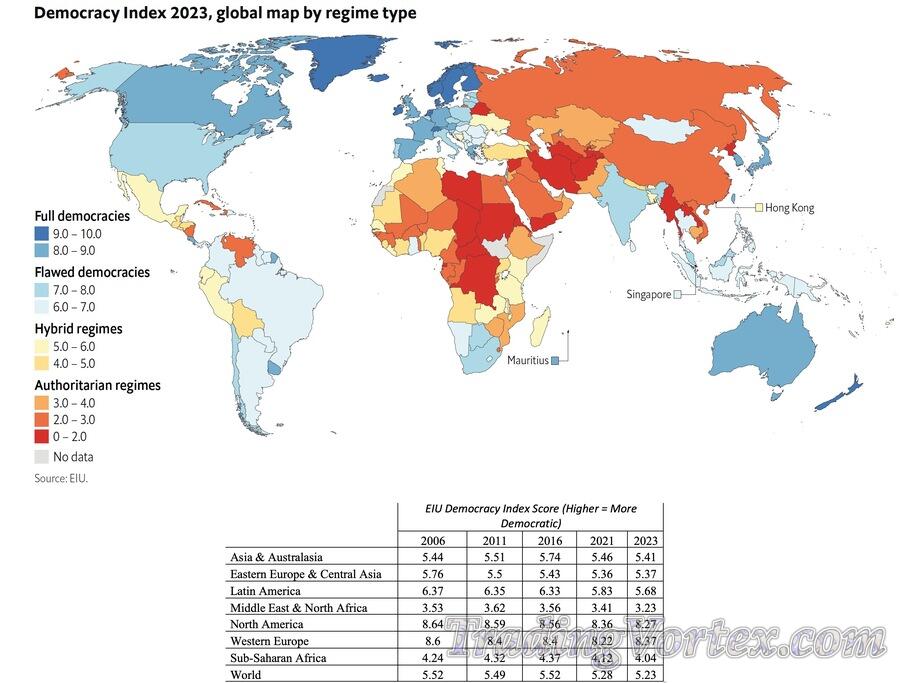
Global Country Risk Heatmap: This world map illustrates the relative country risk premiums — darker shades indicate higher risk — which helps you visually assess the macro backdrop across different regions.
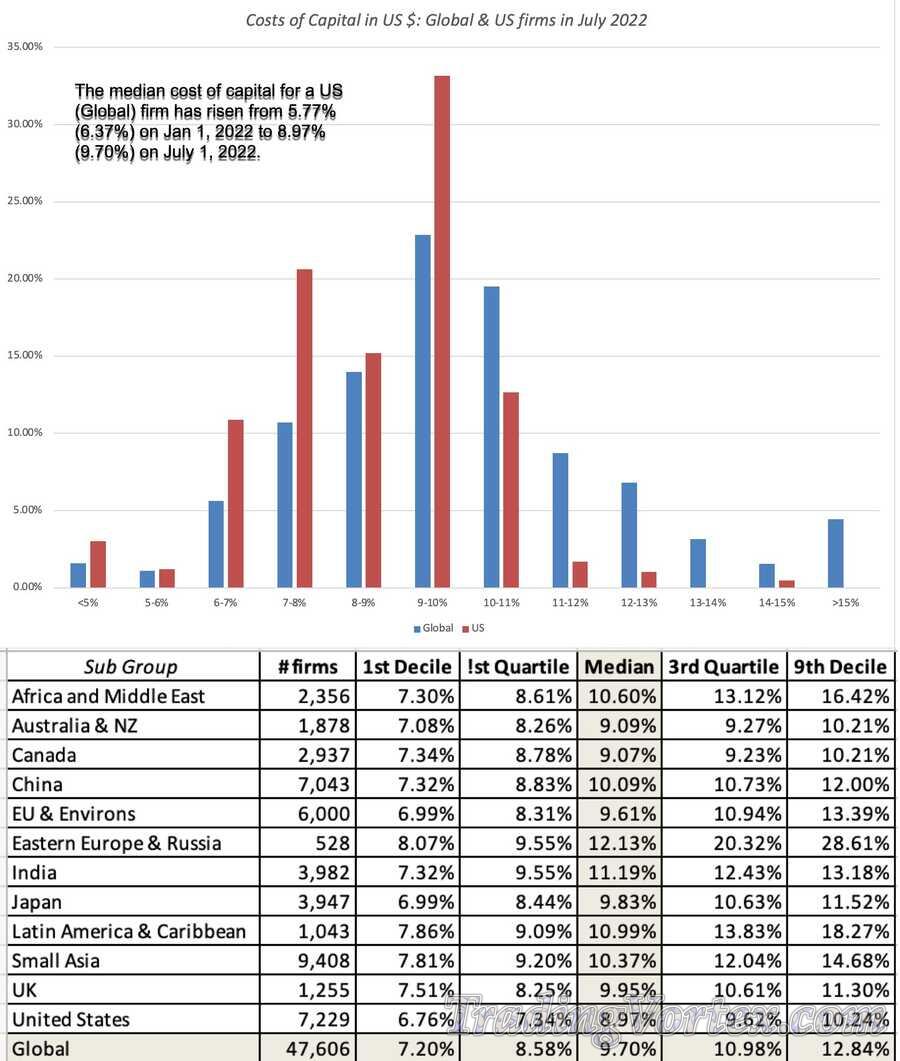
Country Risk Premiums by Country: A bar chart comparing equity risk premiums for various emerging markets, showing how significantly risk levels can vary from one country to the next.

Emerging Market Equity Risk Premium Over Time: A line graph tracking how the emerging market equity risk premium evolves, highlighting periods of elevated risk (spikes) and calmer intervals.
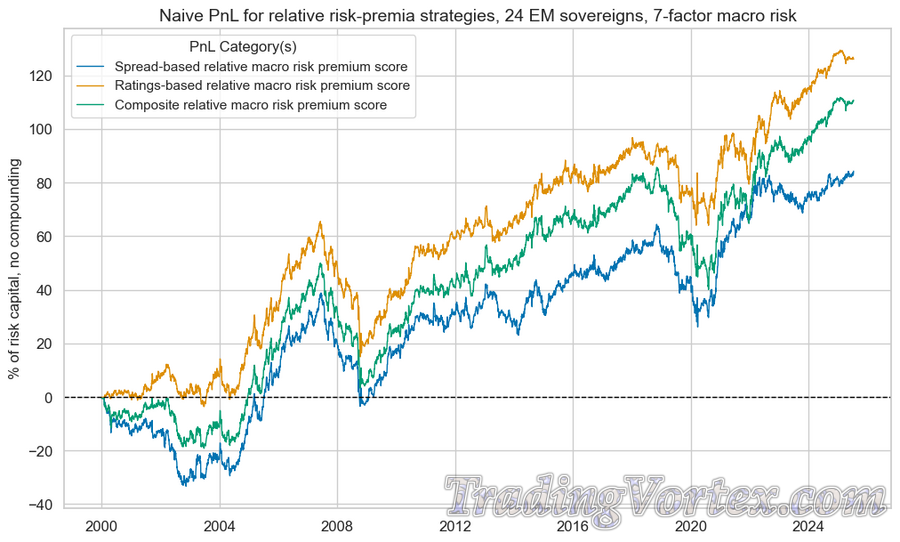
Relative Sovereign Credit Risk Premium Trends: This chart shows how risk-adjusted sovereign credit spreads have changed over time across countries, offering context on broader macroeconomic stress affecting tech firms indirectly.
Portfolio Construction and Position Management:
Putting emerging market tech into a live portfolio is part art, part science, and entirely about risk control. These stocks can deliver big upside, but they also bring higher volatility, liquidity quirks, and country-specific shocks. The goal here is to build a portfolio that captures growth, while keeping drawdowns survivable and allowing you to sleep at night.
Role of EM Tech in a Diversified Portfolio:
Think of EM tech as a growth sleeve inside your broader allocation to equities: it can boost long-term returns, add exposure to faster-growing user bases, and supply thematic exposure to AI, fintech, and cloud adoption outside developed markets. That said, EM tech should normally sit inside a wider allocation that balances value, bonds, and defensive assets, because macro volatility and policy shocks in developing markets tend to be larger and more sudden than in developed markets.
Practical ranges: for most diversified investors, consider allocating 5 to 15 percent of total portfolio assets to all emerging-market equities, with EM tech as a sub-sleeve inside that allocation. If you are a thematic investor or have a higher risk tolerance, EM tech might be 30 to 50 percent of your EM equity sleeve, but only after you accept the volatility and liquidity implications.
Position Sizing, Concentration Limits and Risk Budgets:
Position sizing is your primary defense against the unpredictable. There is no single magic number, but sensible rules of thumb help.
- Risk-per-trade rule: many traders and managers use the 1 to 2 percent rule: risk no more than 1 to 2 percent of portfolio capital on any single trade or position on entry, especially for volatile small-cap EM names. This preserves capital and controls ruin risk.
- Maximum single-name limits: for long-term investors, treat any single-stock position above 5 to 10 percent of portfolio value as a concentrated holding that needs an explicit thesis and exit plan; some advisors label positions above 5 percent as "concentrated" and require special governance.
- Risk budgets: translate your target volatility into a formal risk budget. For example, if your total equity sleeve is expected to contribute X percent volatility, cap EM tech’s share of that volatility to a fixed portion and size positions so aggregate expected volatility stays inside the budget. Institutional frameworks like risk budgeting or Black-Litterman style optimization are widely used to formalize these tradeoffs.
Practical approach: start positions at a pilot size (1–3 percent), then scale up only as your conviction strengthens and as fundamentals or liquidity improve. This conserves dry powder for buying opportunities and limits the damage of early mistakes.
Rebalancing Rules, Stop Losses and Exit Criteria:
Rebalancing and clear exit rules convert good intentions into disciplined outcomes.
- Rebalancing cadence: combine calendar-based reviews with threshold triggers. For many investors, a quarterly check combined with a threshold drift of 100 to 200 basis points (1 to 2 percentage points) provides a sensible tradeoff between turnover and drift. Vanguard research supports threshold-based rebalancing as an effective, low-cost method.
- Stop loss use: stop losses are more common for traders than long-term investors, but they are useful for defined-risk entries: place stops based on volatility-adjusted levels (for example, a multiple of ATR) rather than arbitrary percentages. Be mindful that in thin EM markets, stop orders can gap; consider limit orders or options where available to manage execution risk. Use position size to control loss magnitude rather than relying on stops alone.
- Exit criteria: set clear, pre-mortem exit rules: (a) the investment thesis has broken, (b) unit economics materially deteriorate, or (c) a stress scenario (regulatory shock, capital controls) pushes valuation beyond acceptable downside thresholds. Having explicit triggers avoids emotional sell decisions during panic.
Practical rule of thumb: re-evaluate EM tech holdings quarterly, rebalance if weights drift outside band, and limit single-name volatility by combining small initial stakes, trailing stops for traders, and hard re-evaluation points for investors.
Blending Thematic Bets with Core EM Exposure:
You can pursue thematic ideas without becoming brittle.
- Core-satellite structure: keep a stable, core exposure to broad EM equity or EM-tech ETFs for persistent drivers, then add small satellite thematic positions in higher conviction names or subsectors: AI-enabled fintech, regional e-commerce platforms, or semiconductor suppliers. This balances diversification with upside capture. SSGA and BlackRock analyze how combining core indexed exposure with thematic sleeves can improve ex-ante efficiency.
- Allocation sizing: treat thematic satellites as higher-risk, higher-turnover: keep them smaller, typically 5 to 25 percent of the total EM allocation depending on conviction. Re-assess monthly or quarterly, and be ready to reduce satellites when macro risks rise.
- Implementation path: use ETFs and actively managed funds to get broad thematic exposure cheaply, add single-stock convictions through ADRs or local listings when you have strong conviction and liquidity, and use private or VC allocations only if you have the time horizon and risk tolerance.
Putting It Together – A Sample Playbook:
- Set total EM equity allocation, for example 10 percent of portfolio.
- Allocate an EM tech sleeve, for example 30 percent of EM equity, which equals 3 percent of total portfolio.
- Within that sleeve: hold 60 percent core ETF exposure, 30 percent active fund exposure, 10 percent single-name high-conviction satellites.
- Start single-name positions as pilot stakes (1–3 percent of the sleeve), scale to full size only after confirmation, cap any single stock at 5 percent of total portfolio unless formally approved.
- Rebalance quarterly, use 100 to 200 bps threshold bands, and run scenario stress tests each quarter. Adjust risk budgets if macro or liquidity conditions change.
Behavioral Notes: How to Avoid Common Mistakes?
- Avoid overconfidence: early wins can induce overweighting; keep rules in place to limit drift.
- Don’t confuse conviction with size: conviction should inform selection, not blind concentration.
- Use pilot positions: they are cheap lessons that protect capital while you learn a market.
Final Practical Checklist:
- Have you defined your target EM tech allocation as part of total portfolio?
- Do you use pilot positions and volatility-adjusted sizing for new names?
- Are single-stock and sector concentration limits documented and enforced?
- Is there a clear rebalancing cadence and threshold, with tax and transaction costs considered?
- Do you run regular scenario analyses and update risk budgets when macro conditions change?
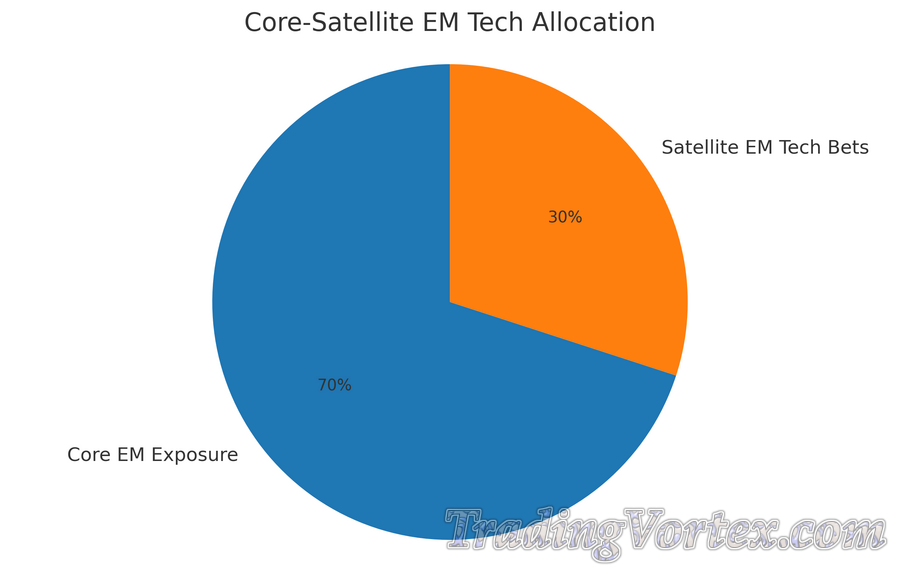 Core-Satellite EM Tech Allocation: This pie chart illustrates a core-satellite portfolio strategy tailored for investing in emerging market technology stocks. The core represents 70% of the portfolio, focused on broad and diversified emerging market exposure through index funds or ETFs, which helps reduce volatility and stabilize returns. The satellite portion, representing 30%, targets high-potential EM tech opportunities such as innovative startups, sector-specific ETFs, or individual growth stocks. This structure allows investors to combine stability with targeted growth opportunities while keeping overall risk in check.
Core-Satellite EM Tech Allocation: This pie chart illustrates a core-satellite portfolio strategy tailored for investing in emerging market technology stocks. The core represents 70% of the portfolio, focused on broad and diversified emerging market exposure through index funds or ETFs, which helps reduce volatility and stabilize returns. The satellite portion, representing 30%, targets high-potential EM tech opportunities such as innovative startups, sector-specific ETFs, or individual growth stocks. This structure allows investors to combine stability with targeted growth opportunities while keeping overall risk in check.
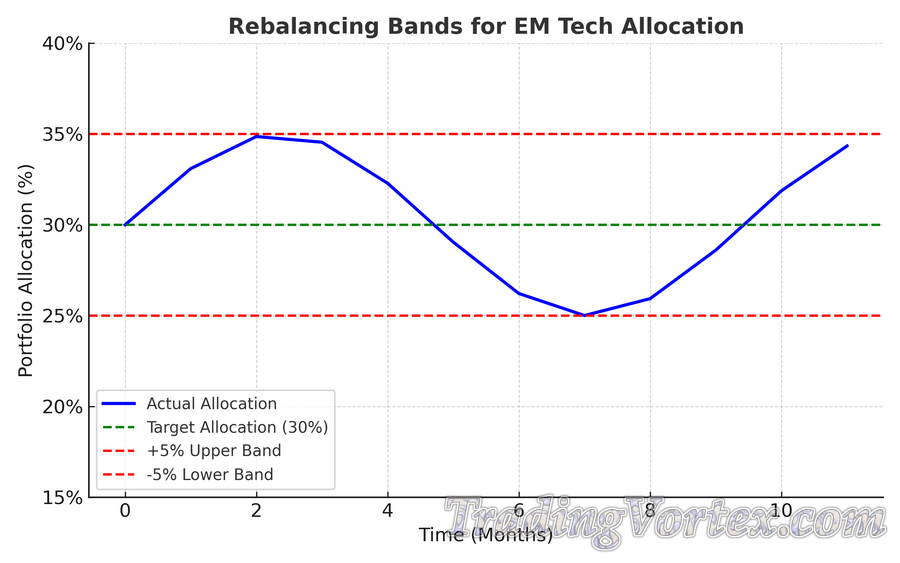 Rebalancing Bands: This line chart demonstrates how rebalancing bands work to keep a portfolio aligned with its target allocation. The middle line represents the target weight for EM tech investments, while the upper and lower bands show the allowable deviation (for example, ±5%) before a rebalance is triggered. When the allocation drifts above the upper band, profits are trimmed and reallocated to other holdings. If it falls below the lower band, more capital is added to EM tech positions. This disciplined approach helps maintain the intended risk profile and ensures investors systematically buy low and sell high.
Rebalancing Bands: This line chart demonstrates how rebalancing bands work to keep a portfolio aligned with its target allocation. The middle line represents the target weight for EM tech investments, while the upper and lower bands show the allowable deviation (for example, ±5%) before a rebalance is triggered. When the allocation drifts above the upper band, profits are trimmed and reallocated to other holdings. If it falls below the lower band, more capital is added to EM tech positions. This disciplined approach helps maintain the intended risk profile and ensures investors systematically buy low and sell high.
Trading, Execution and Tax Considerations:
Trading emerging market tech stocks is part logistics, part psychology, and part negotiation with a far-flung plumbing system. You get great idea flow, but you also inherit different trading hours, sometimes thin liquidity, multiple layers of fees, and tax rules that can surprise you. Below I walk through the real-world mechanics, execution tricks, and tax/reporting points every investor should know.
Trading Across Time Zones and Handling Thin Markets:
Practical realities to keep in mind:
- Settlement cycles and timetables: many markets have moved to faster settlement, but cycles still vary by country, and that affects when trades settle and when you actually own the shares. For example, several major markets have shifted toward T+1 settlement in recent years, which reduces settlement risk but shortens the window for trade corrections and financing. Plan your cash flows accordingly.
- Trade in local active hours when possible: aim to trade during the local session or during session overlaps where liquidity peaks, for example when London and local markets overlap, or near a market’s opening auction. Overlap windows typically see tighter spreads and better depth.
- Thin markets need different execution tools: use limit orders, iceberg order types, TWAP/VWAP algorithms or staged executions to avoid moving the price; retail market orders in thinly-traded EM names can produce huge slippage. If you are large, consider working with a broker to arrange block trades or an over-the-counter execution. Iceberg and slicing algos help hide size and reduce market impact.
Quick trader checklist:
- Check average daily volume and bid-ask spread for the last 30 days; don’t trade blind.
- Prefer limit orders to market orders in thin names, use algos for sizes above a few percent of ADV.
- Know local market open/close and intraday auction windows; time your orders for those liquidity pockets.
- If you need urgency, accept execution premium and size limits; if you don’t, be patient and scale in.
Using ETFs for Tactical Exposure and Rebalancing Efficiency:
How investors use ETFs tactically:
- Tactical entry and exit: ETFs can serve as a temporary vehicle while you build research on a single-name idea, or as a bridge into a region when local listings are illiquid. They are particularly useful for rebalancing at scale.
- Watch tracking mechanics: check whether a fund physically holds local shares or uses derivatives; synthetic or swap-based replication can introduce counterparty risk and different tax/treatment for distributions. Also verify liquidity in both the ETF and its underlying holdings to avoid surprise tracking gaps.
- Cost of active rebalancing: using ETFs reduces per-trade execution friction, but you still face bid-ask spreads and potentially capital gains distributions; manage turnover and tax consequences by planning rebalance cadence.
Practical tip: pair a core ETF sleeve for continuous exposure with small satellite single-name stakes for high-conviction ideas; use the ETF to scale exposure up or down without wrestling thin local order books.
Tax, Withholding and Reporting Issues for International Investors:
Key tax mechanics to remember:
- Withholding taxes vary by country and income type: many countries levy withholding tax on dividends, interest, and sometimes on royalties or similar items; statutory rates differ widely, and tax treaties can reduce the rate if you submit the right paperwork. Use country tax guides to model net yields.
- Documentation matters: foreign investors typically need to provide the correct tax forms to pay agents to claim treaty rates or exemptions; for example, U.S. payers require valid W-8 forms from non-U.S. investors to apply treaty rates or avoid default withholding. Filing or failing to file these forms can change withholding materially.
- Home-country relief: many investors can claim foreign tax credits or deductions to avoid double taxation, but rules differ; for U.S. taxpayers, Form 1116 is the standard route for claiming a foreign tax credit for taxes paid to other countries. Keep detailed broker statements and proof of withholding.
- ADRs and depositary fees: ADRs simplify access but come with depositary bank fees and sometimes extra withholding quirks; check the ADR prospectus and the depositary’s fee schedule for annual custodial or dividend handling fees. Those fees can erode small dividend yields.
Practical tax checklist:
- Before you buy, confirm likely withholding rate on dividends and the documentation required to claim treaty benefits.
- Track all foreign tax withheld, and keep statements for your annual tax filing and foreign tax credit claims.
- If you hold funds or non-U.S. mutual funds, check special rules like PFIC (for U.S. taxpayers), which can have punitive tax treatment.
- When in doubt, consult a cross-border tax adviser; the cost often pays for itself.
Cost Management – Commissions, FX Spreads and Custody Fees:
Where the costs hide:
- Commissions and broker fees: different brokers have different fee structures for foreign-exchange conversions, overseas order routing, and exchange fees; shop for brokers that provide transparent pricing and good global market access. Some brokers offer “dollarized” international execution to avoid double conversions. Compare live commission schedules before you trade.
- FX spreads and conversion costs: converting into local currency to buy a stock, or receiving dividends in a foreign currency, usually incurs a spread and sometimes a commission; these can be larger than expected for exotic currencies. For larger or recurring flows, compare the effective all-in FX rates across providers.
- Custody and sub-custodian fees: global custodians and local agent banks charge safekeeping and settlement fees; these are often expressed as basis points of assets under custody plus per-transaction fees. Smaller accounts feel these fees proportionally more; consider this when choosing direct local exposure versus an ETF or ADR.
- ADR and depositary fees: ADRs are convenient, but the depositary bank can take a custodial or pass-through fee that reduces net dividend income and total return; read the ADR fee clause in the deposit agreement.
Practical cost rules:
- Use brokers with competitive international pricing if you plan to trade often; for occasional exposure, ETFs or ADRs often beat the total cost of direct local trades once you include custody and FX costs.
- For recurring dividend income, model the net yield after withholding, ADR fees, and FX conversion; if the net yield is low, consider ETFs or funds that reinvest more efficiently.
- Negotiate custody and execution fees if you are institutional or trade substantial sizes; sub-custodian networks and direct market access lower costs for frequent traders.
Short, Actionable Execution Checklist:
- Pre-trade: check local volume, ADV, bid-ask spread, trading hours, and settlement cycle.
- Order type: use limit orders in thin markets; use algos for large sizes, and staged entries for high-impact trades.
- Settlement: confirm cash and margin windows given local T+ settlement rules, avoid forced selling during funding shortfalls.
- Post-trade: reconcile fills, check brokerage FX conversions, save statements for tax credit or treaty claims.
- Ongoing: review custody fees annually, and re-evaluate access method if cost or liquidity profile changes.
Final note, from one trader to another:
I’ve lost more than one trade by treating an emerging market like a U.S. blue chip, and I’ve also watched small, illiquid positions bloom into big winners after patient scaling.
The trick is to respect the plumbing: know the hours, control execution risk, price in taxes and custody, and use ETFs or ADRs when execution or tax complexity is not worth the extra alpha.
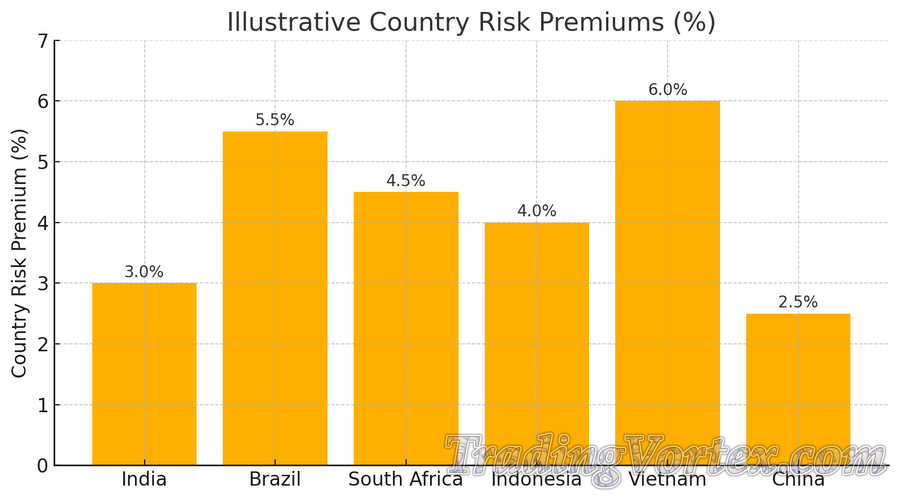 Country Risk Premiums in Emerging Markets: This bar chart compares the additional return investors typically expect when investing in different emerging market countries. It visually shows how markets like Brazil or Turkey carry higher perceived risk premiums compared to others like India or Thailand, which can influence portfolio weighting and required return targets.
Country Risk Premiums in Emerging Markets: This bar chart compares the additional return investors typically expect when investing in different emerging market countries. It visually shows how markets like Brazil or Turkey carry higher perceived risk premiums compared to others like India or Thailand, which can influence portfolio weighting and required return targets.
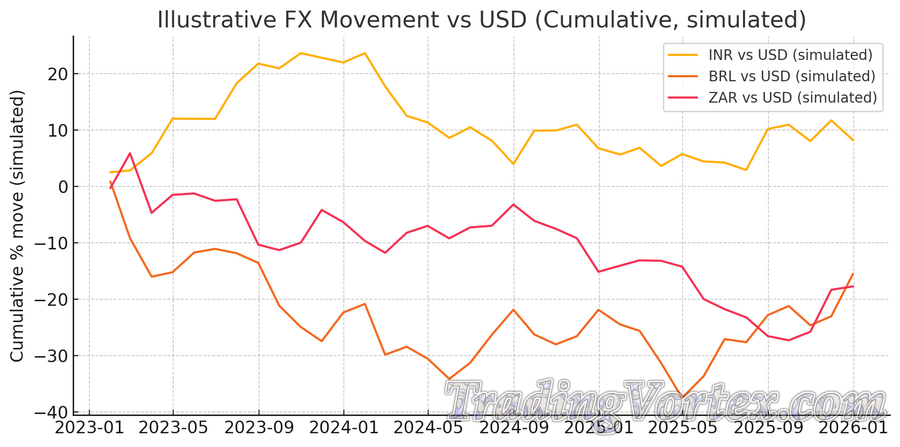 Currency Movement vs. USD – Cumulative Impact on Returns: This line chart tracks the simulated cumulative movement of select EM currencies against the US dollar over time. It highlights how currency volatility can significantly enhance or erode returns, even if the underlying stock performance is solid, making FX risk management a crucial part of any emerging market strategy.
Currency Movement vs. USD – Cumulative Impact on Returns: This line chart tracks the simulated cumulative movement of select EM currencies against the US dollar over time. It highlights how currency volatility can significantly enhance or erode returns, even if the underlying stock performance is solid, making FX risk management a crucial part of any emerging market strategy.
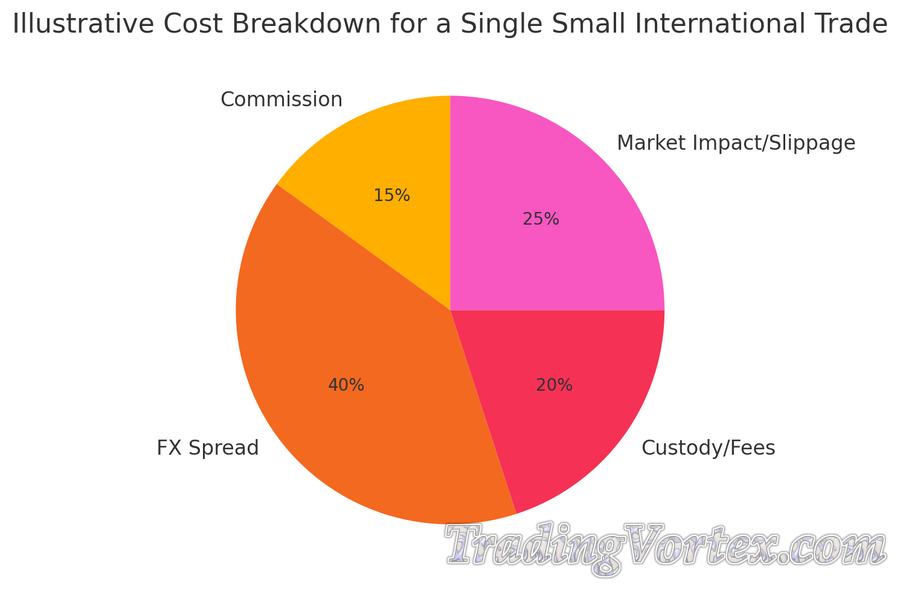 Trade Cost Breakdown for a Small International Equity Trade: This pie chart breaks down the estimated costs of executing a single small trade in an emerging market stock. It includes commissions, FX spreads, custody fees, and market impact, illustrating that hidden costs can materially affect net returns if not actively managed.
Trade Cost Breakdown for a Small International Equity Trade: This pie chart breaks down the estimated costs of executing a single small trade in an emerging market stock. It includes commissions, FX spreads, custody fees, and market impact, illustrating that hidden costs can materially affect net returns if not actively managed.
Practical Risk Mitigation Techniques:
If emerging-market tech investing were a sport, risk mitigation would be your warm-up: the better you prepare, the fewer nasty sprains you get. This section gives you practical tools to manage the big observable risks: currency swings, sudden regulatory or market shocks, governance blind spots, and the friction of illiquid markets. Think of it as a succinct playbook you can use before and after you press Buy.
Currency Hedging Strategies and When to Use Them:
Common tools and how they work:
- Forwards and Non-Deliverable Forwards (NDFs): Forwards lock an exchange rate for a future date, NDFs do the same but settle in a hard currency rather than exchanging the local banknote. NDFs are widely used for currencies that are restricted or have thin forward markets, they are standard instruments for hedging EM currency exposure.
- Currency futures and swaps: These can be used where listed futures exist; swaps are useful for longer-dated needs and for institutions that want to match foreign-currency liabilities.
- Currency ETFs and ETNs: Useful for smaller investors who want simple, tradable hedges without OTC counterparty exposure. They are less precise than forwards, but often cheaper and more accessible.
- Dynamic or tactical hedging: Instead of full-time hedging, use a partial hedge (for example 30 to 70 percent of expected exposure), rebalancing based on volatility, carry, or macro triggers. This balances cost and protection.
- Natural hedges: Prefer companies with dollar-linked revenues, low foreign-currency debt, or operations that naturally offset FX exposure.
When to hedge? practical rules of thumb:
- Hedge more when the local currency is volatile, the company has significant foreign-currency liabilities, or your investment horizon is short.
- Consider partial hedges for long-term, high-conviction positions where currency is expected to mean-revert; fully hedge when the company’s cash flows are dollar-linked but you are holding local-listed shares.
- Model hedging costs: hedging premiums rise with implied FX volatility, and demand spikes during political or trade-policy shocks can push costs higher. Be realistic about ongoing hedge roll costs.
Use of Derivatives, Options and Structured Products for Protection:
Options for equity protection:
- Protective puts: Buying put options gives you a floor while allowing upside participation; this is great when you want to avoid realizing taxable gains yet lock in downside protection. Options are tax-aware hedges for investors with large embedded gains.
- Collars: Buy a put and sell a call to finance the protection; collars reduce cost but cap upside. They work well when you have a view that downside risk dominates near term.
- Index or ETF options: If single-name options are illiquid, use options on an EM tech ETF or an index as a proxy hedge; correlation is imperfect but often better than nothing.
Futures and total return swaps:
Short futures or swap positions can synthetically reduce exposure; they are efficient for large or institutional positions, but beware margin and liquidity requirements.
Structured products and capital-protected notes:
Banks offer structured notes that combine principal protection with capped upside, these are sometimes used to gain EM tech exposure with downside buffers. They can be useful in yield-starved environments, but they carry counterparty and complexity risk: costs can be embedded and terms are often opaque. Understand the issuer, read the payoff mechanics, and treat them as bank credit exposure rather than pure market exposure.
Tradeoffs and warnings:
- Liquidity matters: EM single-name options can be thin or unavailable, making hedges costly or impossible. Use ETF/index hedges when single-name markets are thin.
- Collateral and margin: derivative hedges can trigger margin calls in volatile markets; ensure you have liquidity buffers. The financial stability authorities note how margin and NBFI liquidity needs can amplify stress during market shocks. Use derivatives carefully and factor in liquidity.
Diversification Across Countries, Subsectors and Cap Sizes:
Diversification is the oldest trick in the book, and in EM tech it remains one of the best defenses.
How to implement effectively:
- Cross-country mix: diversify across at least 3 to 6 countries that have independent policy cycles, pick different listing venues to reduce repatriation risk.
- Subsector diversity: mix fintech, cloud/SaaS, semiconductors and consumer platforms; each reacts differently to macro moves.
- Cap-size breadth: include large-cap leaders for stability, mid-caps for growth, and a small allocation to high-risk, high-reward small caps or private deals. Typical tactical splits might be 60 percent large-cap, 30 percent mid-cap, 10 percent small-cap for a growth sleeve, adjust to your risk tolerance.
- Instrument mix: combine ETFs or active funds (core) with single-stock satellites; ETFs reduce governance and liquidity risk while satellites capture idiosyncratic upside.
Practical note: diversification reduces idiosyncratic failure risk, but it does not eliminate currency, systemic or global liquidity shocks. Always stress-test a diversified basket in scenarios with simultaneous EM drawdowns.
Governance Screening and Third-Party Risk Checks:
Governance failures, related-party deals and weak auditing are big value destroyers in EM markets. Doing the homework is non-negotiable.
Screening tools and sources:
- Third-party ESG and governance providers: MSCI and Sustainalytics provide governance scores, controversy flags and research that are useful starting points for screening; treat these as signals, not final verdicts.
- World Bank and OECD frameworks: use red-flag checklists from the World Bank or OECD to scan for classic governance issues like lack of board independence, opaque ownership, frequent auditor changes, and related-party transactions. These frameworks give you a structured checklist to apply consistently.
- Local filings and newsflow: read local regulatory filings, audit reports, and credible local press; many governance issues show up first in regional reporting. Short-seller reports and litigation filings can be noisy but are sometimes early warning signs.
- Third-party vendor checks: for supply-chain or counterparty risk, use commercial due-diligence providers, background checks, and supplier audits to validate claims about major customers or partners.
Practical approach:
- Implement a governance kill-switch: if a company fails key governance thresholds (for example, material related-party revenue, recurring auditor changes, or unexplainable cash outflows), reduce the position or require senior management engagement.
- For meaningful exposure, consider active stewardship: engage management, exercise voting rights, or partner with institutional investors to push for transparency improvements.
Putting It Together – A Simple, Practical Checklist:
- Hedge decision: Is currency risk likely to materially change your expected return? If yes, choose forward/NDF or ETF hedge; if not, consider partial or dynamic hedging.
- Protection instrument: Are single-name options liquid? If no, use index/ETF options or collars where possible. Factor in margin requirements and tax treatment.
- Diversification rules: Hold exposure across multiple countries, subsectors and cap sizes; keep single-name caps in place and maintain a core-satellite structure.
- Governance gates: Run an ESG/governance screen using MSCI/Sustainalytics scores, then deep-dive local filings for red flags before increasing size.
- Liquidity planning: Use limit orders, scale in, and prefer ETFs/ADRs when local market liquidity is low; keep cash reserves to meet derivative margin calls.
- Insurance and guarantees: For large institutional investments consider political risk insurance or World Bank Group guarantees; these can reduce repatriation and expropriation risk for big projects.
Final, Practical Tip (from someone who’s learned the hard way):
Start small, test your hedges in calm markets, and measure the real all-in cost of protection: premiums, roll costs, margin and counterparty fees. Some hedges feel great on paper and eat your returns in practice. If you combine thoughtful hedging, sensible diversification, and rigorous governance screening, you will avoid most of the common EM tech traps while still being able to capture meaningful growth.
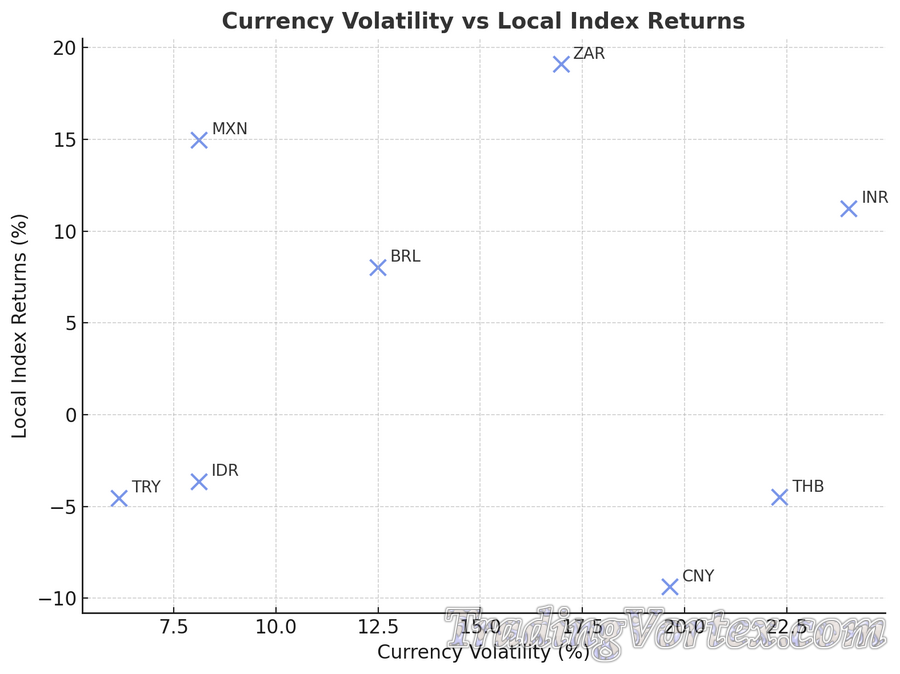 Currency Volatility vs Local Index Returns: This chart compares how much a country’s currency moves against the U.S. dollar with how its local tech stock index performs.
Currency Volatility vs Local Index Returns: This chart compares how much a country’s currency moves against the U.S. dollar with how its local tech stock index performs.
The idea is simple: high currency volatility often increases the unpredictability of your returns if you are investing from abroad. For example, even if a country’s tech stocks are booming, a sudden currency drop can wipe out most of your gains once you convert back to your home currency.
How to use it:
♦ If you notice strong returns paired with low currency volatility, that market might offer a smoother ride for foreign investors.
♦ If returns look good but volatility is sky-high, you may want to consider hedging part of your currency exposure to protect profits.
♦ If both are negative, it’s a warning sign to tread carefully, or to only take small tactical positions.
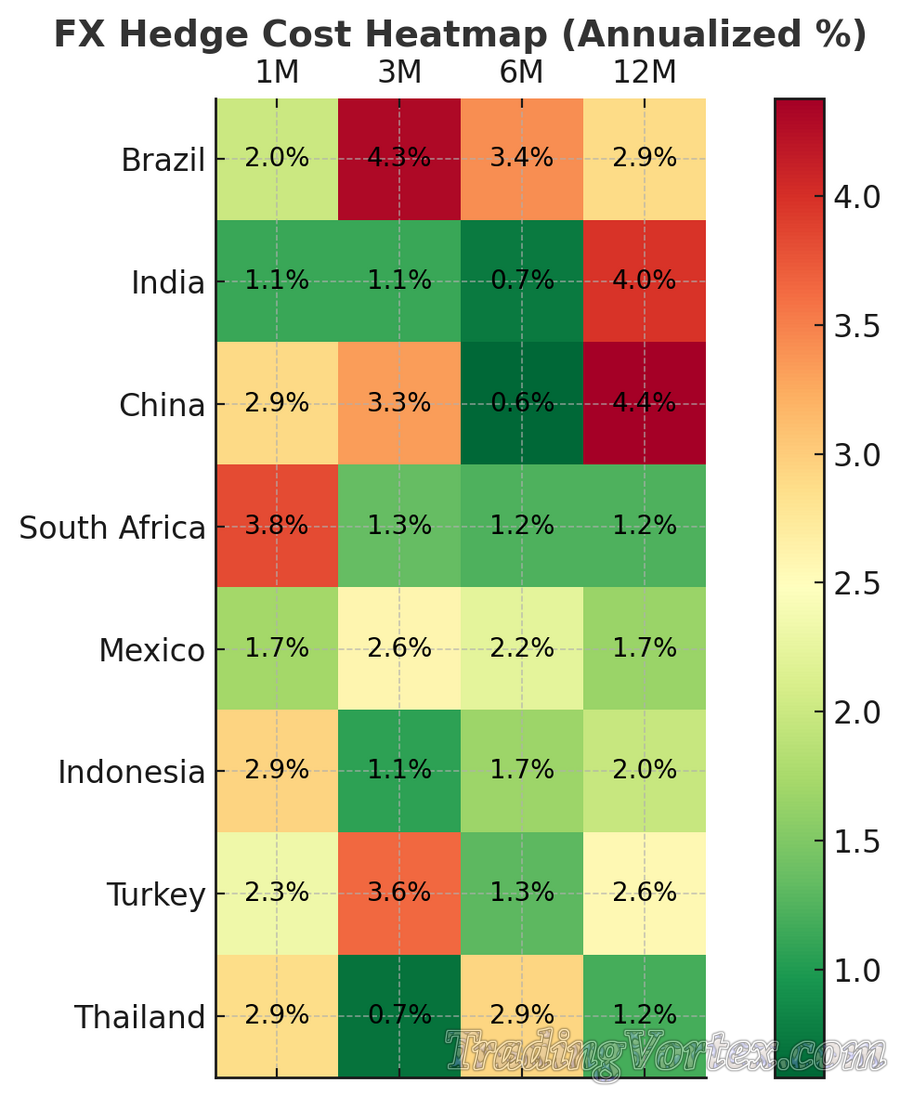 FX Hedge Cost Heatmap: This heatmap shows the estimated cost of hedging different emerging market currencies over short, medium, and long terms. Hedge costs depend on interest rate differentials, liquidity, and market conditions. The darker the color, the more expensive the hedge.
FX Hedge Cost Heatmap: This heatmap shows the estimated cost of hedging different emerging market currencies over short, medium, and long terms. Hedge costs depend on interest rate differentials, liquidity, and market conditions. The darker the color, the more expensive the hedge.
Why it matters: Hedging is not free, and in some markets it can be so costly that it eats away a big chunk of your expected returns. For example, hedging the Brazilian real or Turkish lira for a year might be very expensive because of high local interest rates. On the other hand, currencies from markets with more stable monetary policies can be surprisingly cheap to hedge.
Practical takeaway:
♦ Use short-term hedges in high-cost markets to cover specific events, like elections or central bank meetings.
♦ In low-cost markets, you might maintain a rolling hedge to smooth out long-term volatility.
♦ Always weigh hedge cost vs potential currency risk before deciding; sometimes the cost of protection outweighs the benefit.
Due Diligence Checklist: What to Verify Before You Buy?
Buying a tech stock in an emerging market without proper due diligence is like boarding a plane without checking the weather: you might land safely, or you might get bounced around by turbulence you could have seen coming.
Below is a practical, field-tested checklist that combines accounting sleuthing, legal verification, and local-context checks. Read it like a traveller’s packing list: skip nothing essential, and prepare for the odd surprise.
Quick orientation: how to use this checklist?
Treat this as a pre-buy playbook. For every prospective position, run the items below, mark green/amber/red, and escalate any red items to specialist checks: forensic accountant, local counsel, or regulator briefing. Use local filings and audit reports as primary sources, supplement with reputable third-party data and local news, then document conclusions.
Corporate Structure, Ownership and Related Parties:
What to verify:
- Ownership map: obtain a clear chart of direct and indirect shareholders, percent ownership, and any ultimate beneficial owners. Check for cross-holdings and SPVs that obscure control.
- Voting rights and shareholder classes: confirm whether dual-class shares, golden shares, or special voting rights concentrate control; these change how corporate decisions are made.
- Related-party transactions: review schedules in annual reports for sales, loans, guarantees, or leases with related parties; quantify their size and economics relative to consolidated revenue. Repeated or large related-party deals need detailed explanation.
- VIEs and special structures: in some jurisdictions, Variable Interest Entities (VIEs) or contractual structures are used to bypass ownership rules; understand the legal enforceability and regulatory sentiment toward such structures.
- Cross-border holding risks: if the parent or key assets are in another jurisdiction, confirm legal protections and potential for upstream transfers or dividend restrictions.
Why this step is grounded in best practice: international due diligence frameworks emphasize mapping ownership and related parties as foundational to responsible investing.
Financial Statements, Auditing Standards and Restatement Red Flags:
What to verify:
- Audit firm and audit opinion: check the auditor’s name and opinion type. Big, reputable auditors do not guarantee perfection, but repeated auditor switches or modified opinions are red flags.
- Accounting standards used: confirm whether the company reports under IFRS, local GAAP, or U.S. GAAP, and be sure you understand key recognition differences.
- Restatements and prior adjustments: look for history of restatements, late filings, or regulatory accounting inquiries; repeated adjustments signal control or reporting problems.
- Cash vs reported earnings: reconcile net income to operating cash flow; growing receivables or widening gaps between cash and accounting revenue deserve scrutiny.
- Unusual line items: watch for large “other income,” aggressive capitalization of costs, or sudden gains from related-party disposals; these can mask recurring weakness.
- Forensic ratios and red flags: apply simple checks like the Beneish M-Score, revenue days outstanding trends, and margin step-changes that lack operating explanations. Resources on common fraud red flags and detection techniques are useful reference points.
Practical escalation: if you see audit-modified language, material restatements, or cash/earnings divergence, commission a forensic review before increasing position size.
Customer Base, Contracts and Revenue Concentration:
Why it matters: a single large customer can be a blessing and a curse: great for near-term cash, risky for long-term independence. In EM tech, reliance on a handful of enterprise or government customers can threaten stability.
What to verify:
- Top customers list and % of revenue: identify the share of revenue from top 5 and top 1 customers; anything above 20 to 30 percent for a single customer warrants detailed contract review.
- Contract terms and duration: review key contracts for termination clauses, renewal mechanics, pricing resets, and exclusivity terms. Short-term or cancellable contracts mean higher churn risk.
- Revenue recognition mechanics: ensure revenue is recognized according to the contract economics, not simply on invoice issuance; check recognition around upgrades, refunds, and deferred revenue.
- Renewal, churn and concentration trends: ask for cohort-level retention data, ARPU evolution, and whether new customer wins offset churn. Tech-specific metrics like net revenue retention can reveal underlying health.
- Dependency on state or quasi-state customers: contracts with government entities can be lucrative but expose the company to political shifts and delayed payments; verify historical payment performance.
Customer-concentration calculators and guidance help quantify this risk during modeling.
Management Track Record, Insider Activity and Incentives:
What to verify:
- Executive and board biographies: check work history, industry reputation, previous IPO or scale-up experience, and any gaps that need explaining.
- Insider transactions and lock-ups: review the pattern of insider buying and selling, option grants, and lock-up expiry schedules; repeated opportunistic selling near lows is a cautionary sign. Public registrar filings and insider transaction trackers are useful tools.
- Incentive structure: analyze executive compensation: are incentives tied to sustainable profitability, cash flow, or short-term revenue targets? Poorly designed incentives can encourage risky accounting or short-termism.
- Reputation checks: run background checks, search local press for governance controversies, regulatory complaints, or lawsuits involving senior management. Local-language sources often reveal useful context.
- Organizational depth: assess second-line management and whether the company can survive executive churn without execution breakdown.
Practical tip: treat insider buying as a positive signal when it is material and sustained, but always interpret insider selling within context: diversification, tax needs, or share plans can drive sales for benign reasons.
Legal, Regulatory and Compliance Review Steps:
What to verify:
- Licenses and permits: confirm required operating licenses are in force and transferable where relevant. For fintech, confirm payments, lending and e-money authorizations.
- Regulatory inquiries and enforcement history: search for ongoing investigations, fines, or enforcement actions; recent upticks in regulatory scrutiny of fintech and platform businesses are well-documented. If regulators have imposed sanctions, quantify the operational and financial impact.
- Data, privacy and cross-border rules: identify where customer data is stored, any localization requirements, and compliance with local privacy laws that could restrict cross-border transfers or cloud hosting.
- IP ownership and contractual rights: verify that key IP is owned by the company, or that contracts clearly grant necessary rights; ambiguous IP ownership can derail product monetization or M\&A exits.
- Litigation and contingent liabilities: review legal disclosures for pending litigation, tax disputes, or guarantees that could create material contingent liabilities.
- Sanctions and reputational screening: screen counterparties and major shareholders against sanctions lists and AML watchlists, particularly in regions with heightened geopolitical risk.
- Cross-border listing and repatriation issues: if the company relies on foreign listings or repatriation of dividends, confirm the legal and practical ability to transfer capital across borders.
Country-level investment policy and regulatory reviews help frame the legal backdrop and reveal historical patterns of controls or restrictions.
Final – A Practical Red-Flag Scoring Grid:
Use this quick scoring method for each company, then escalate any item scoring amber or red:
- Ownership clarity: Green if simple and transparent, Amber if layered SPVs, Red if unknown UBOs or opaque VIEs.
- Audit quality: Green for Big Four with clean opinion, Amber for mid-tier auditors or qualified opinions, Red for restatements or modified opinions.
- Customer concentration: Green if top client <20%, Amber if 20–40%, Red if >40%.
- Cash quality: Green if operating cash flow covers capex and working capital, Amber if marginal, Red if negative or worsening.
- Management alignment: Green if insiders hold material stakes and incentives are long-term, Amber if compensation unclear, Red if suspicious selling or short-term incentive bias.
- Regulatory exposure: Green if low or well-managed, Amber if pending inquiries, Red if active enforcement or license at risk.
Document the score, attach source references for each item, and require specialist review for any red flags before committing material capital.
Closing note, from the desk of someone who’s done the rounds:
Due diligence in emerging markets is not a checklist to skim, it is a discipline. It pays to be both curious and slightly paranoid: verify what management says against filings, test contract clauses in translation, and never assume global standards apply locally. When you combine structured checks, local intelligence, and specialist escalation for red flags, you dramatically raise the odds of picking winners and avoiding the headline-making disasters.
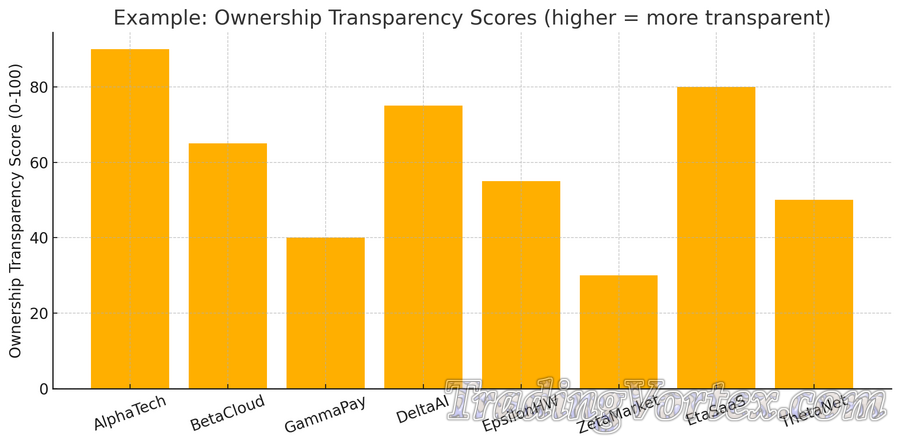 Ownership Transparency Scores:
Ownership Transparency Scores:
What it shows: This chart ranks companies based on how transparent they are about their ownership and related party transactions. Higher scores mean the company clearly discloses its major shareholders, affiliates, and control structures. Lower scores often signal opaque ownership that could hide conflicts of interest.
How to use it: If you see a low score, it’s a red flag to dig deeper. In emerging markets, hidden connections can influence everything from contract awards to regulatory treatment. The higher the transparency score, the easier it is for you to trust the governance structure.
 Customer Concentration (ExampleCo):
Customer Concentration (ExampleCo):
What it shows: A pie chart showing the percentage of total revenue coming from each customer. In this example, one client makes up more than 40% of sales, which creates a heavy dependency risk.
How to use it: If a company relies too much on one or two customers, losing that relationship could tank revenue. Ideally, look for a more balanced distribution, or check if long-term contracts are in place to protect those key accounts.
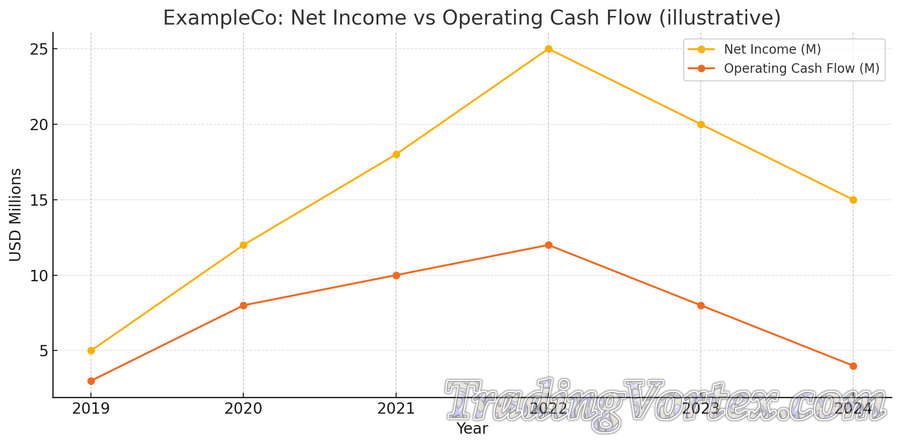 Net Income vs Operating Cash Flow:
Net Income vs Operating Cash Flow:
What it shows: A side-by-side bar comparison for several years, revealing whether a company’s reported profit matches the actual cash it generates from operations. Large, consistent gaps can be a warning sign of aggressive accounting or unsustainable earnings.
How to use it: Healthy companies usually have operating cash flow that’s equal to or greater than net income. If the gap is negative year after year, take a closer look at working capital changes and non-cash adjustments in the financial statements.
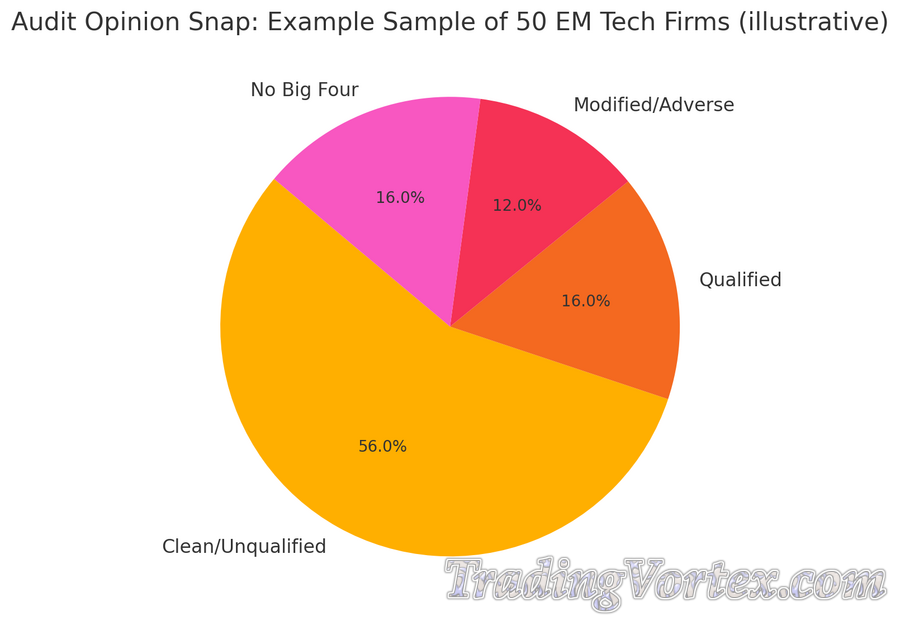 Audit Opinion Distribution (Sample):
Audit Opinion Distribution (Sample):
What it shows: A bar chart illustrating the proportion of companies receiving clean (unqualified) audit opinions versus those with qualified, adverse, or disclaimer opinions. In the sample data, a significant percentage are not fully clean.
How to use it: An unqualified opinion means auditors believe the financial statements are fair and accurate. Any other type of opinion should prompt a review of the auditor’s notes to understand the issue, especially in emerging markets where auditing standards can vary.
Case Studies and Lessons from Recent Market Events:
Stories stick. Below are four compact case studies that show how big themes play out in real markets: China’s regulatory shock and partial recovery, India’s structural growth and IPO activity, semiconductor supply chain moves in Taiwan and Korea, and governance/accounting failures that crushed shareholder value. For each case I give the headline, what happened, and practical lessons you can use when sizing, valuing, and managing positions.
China Tech – Regulatory Shock and Recovery Lessons:
What happened: From late 2020 onward China implemented a broad regulatory sweep across tech, covering antitrust, data security, and fintech rules. High-profile examples included the blocking of Ant Group’s 2020 IPO plans, intense scrutiny of ride-hailing and platform firms, and temporary operational restrictions that cut into growth and liquidity for many listed names. Since 2024 and into 2025, Beijing has signaled more explicit support for tech innovation, rolling out financial backing for science and technology firms and easing some listing and capital measures, which helped investor sentiment and supported recoveries in some formerly-sanctioned firms.
Real-world signal: Didi is a clear example: after sharp regulatory pain in 2021, the company has shown sequential recovery in revenues and activity as it restructured, paid fines, and re-engaged regulators; the turnaround did not happen overnight, but disciplined adaptation and clearer compliance posture helped restore parts of the business.
Lessons for investors:
- Treat regulation as a scenario, not a tail event: build regulatory stress cases into valuation models, and ask how a company would perform if it lost a major revenue channel, or had to localize data storage quickly.
- Look for management and governance fixes: companies that visibly change compliance practices and governance after a shock tend to recover more credibly.
- Access route matters: A-share, Hong Kong, and ADR listings each expose you to different legal and liquidity regimes; adjust position sizing accordingly.
- Patience pays: recoveries can be multi-year, your timing should match the likely horizon of regulatory normalization and policy support.
India Tech – Structural Growth and Valuation Dynamics:
What happened: India’s tech ecosystem has kept expanding: rising smartphone penetration, the ubiquity of UPI payments, and a deepening startup-to-public pipeline produced a busy IPO market in 2024 and 2025. India showed resilience in public listings, with many new issuers and increasing investor appetite for scalable platform and SaaS stories. Institutional reports show India as one of the top IPO markets in early 2025.
Real-world signal: The mix of listed software services, fintech, and platform businesses means investors can often find companies with improving unit economics and clearer monetization paths than in earlier subsidy-driven cycles. That said, valuations for high-growth names can run hot relative to local fundamentals, prompting careful scrutiny of metrics like ARPU and retention.
Lessons for investors:
- Value growth quality, not just growth: prioritize companies where user growth is meaningfully converting to revenue growth and improving unit economics.
- Use local benchmarks: compare valuations to domestic peers and factor in India's lower country-risk premium relative to some frontier EMs.
- Watch IPO windows: listing momentum can bring new supply and repricing; be cautious around frothy issuance periods and look for durable profitability signals where possible.
- Infrastructure tailwinds matter: public investments and digital rails like UPI materially expand addressable markets, so tilt exposure to firms that leverage these rails.
Semiconductor Supply Chain Wins – Taiwan and Korea Examples:
What happened: Taiwan and South Korea remain central to global chip supply, with firms investing heavily in capacity and R\&D. TSMC’s major capital programs, plus new fab investments driven by global incentives, have supported demand for advanced packaging and foundry services. Korea’s memory manufacturers also regained momentum on cyclical recovery and strategic investment. These moves have underscored how EM-linked hardware plays can capture durable, structural demand even in volatile macro periods.
Real-world signal: TSMC’s large-scale investment announcements and capacity shifts provide revenue visibility to suppliers and regional ecosystems, while policy initiatives such as CHIPS-like incentives globally make supply chain diversification a multi-year story rather than a short-term trade. At the same time, firms prune legacy capacity when economics demand it, such as the phased rationalization of less efficient production lines.
Lessons for investors:
- Focus on contractual visibility: suppliers with multi-year contracts or confirmed customer commitments tend to be safer than speculative small-cap entrants.
- Expect cyclicality and policy noise: semiconductors are capital intensive, they swing with end-demand and geopolitical policy; model longer capex payback and sensitivity to tariffs or export controls.
- Local policy tracking is alpha: government subsidy announcements, export-control changes, and cross-border incentives materially change the revenue outlook for fab builders and equipment suppliers.
What Went Wrong? Governance and Accounting Failures:
What happened: Governance and accounting scandals can destroy value fast. Luckin Coffee’s accounting fraud, exposed in 2020, is a canonical example: fabricated sales inflated the top line, trading collapsed, and shareholders suffered massive losses; the case led to large enforcement actions and class settlements. Similarly, governance crises at some fast-growing startups, such as publicized leadership and governance breakdowns at BharatPe, have created investor losses and long remediation processes.
These examples highlight that growth alone is not enough without governance controls and transparent financial reporting.
Lessons for investors:
- Do governance homework before size-up: review auditor changes, related-party deals, insider transactions, and the clarity of ownership structures.
- Forensic checks are inexpensive insurance: reconcile cash flows to reported earnings, scrutinize large “other” items, and flag repeated restatements for escalation to specialist review.
- Be skeptical of too-good growth stories: when growth looks unusually smooth, or margins bounce in unexplained ways, dig deeper; many frauds exhibit consistent patterns in receivables and cash flow divergence.
Cross-Case Takeaways: How to Apply These Lessons When Investing?
- Scenario-first valuation: always build a regulatory or governance downside scenario and check whether the investment still works under it.
- Access and liquidity matter: where a company lists and how liquid it is can determine whether you can exit if a shock hits.
- Management and compliance are non-negotiable: after a major policy shift, companies that quickly adjust governance and compliance tend to recover faster.
- Sector fits dictate modeling: semiconductors need capex and cycle models, fintech needs regulatory and customer-concentration models, platforms require metrics on monetization curves.
- Diversify across events: don’t assume every country will face the same regulatory narrative at the same time; diversification across regions and subsectors reduces single-event harm.
Step by Step Action Plan for Investors and Traders:
Quick framing: investor or trader?
Decide your role first, because everything else flows from that choice.
- Investor: multi-year horizon, focus on fundamentals, governance and runway, use ETFs or direct listings for core exposure, single names as satellites.
- Trader: days to months horizon, focus on liquidity, technicals, execution and short-term triggers, use ETFs and ADRs when local books are thin.
Both roles share the same research inputs, but the decision rules, sizing and time horizon differ.
Step 1 – Research workflow and sources to follow:
Goal: build a fast, repeatable flow that lets you separate signal from noise.
Daily scan (15–30 minutes):
- Macro & market pulse: quick reads of global macro updates from Vanguard, BlackRock or JPMorgan to set the backdrop; this helps you see when policy or liquidity regimes are shifting.
- Local market news: subscribe to region-specific feeds (local business press, exchange filings, regulator notices) and set alerts for companies on your watchlist.
- Company ops & metrics: pull quarterly filings and management commentary; track KPIs such as active users, ARPU, net revenue retention, CAC payback, and GMV where relevant. Sector reports such as McKinsey on fintech and platform economics are gold for context.
- Execution & liquidity check: always check average daily volume and bid-ask spreads before planning a trade; for execution tactics consult algo or execution guides (VWAP, TWAP) to reduce market impact.
Practical template: morning scan = 15 minutes, watchlist deep-dive = 60–90 minutes weekly, filing read for any company you plan to buy = full reading of latest quarterly plus MD\&A.
Step 2 – Screening for high-conviction opportunities:
Goal: quickly filter 100 ideas down to a handful worth deeper work.
Start with quantitative screens, then apply qualitative filters:
Quantitative screens (example baseline):
- Revenue growth: > 15–20% YoY for publicly traded EM tech (adjust per subsector).
- Improving unit economics: CAC payback under 24 months for fintech/SaaS, rising contribution margin per transaction.
- Balance sheet runway: at least 12 months of cash runway at current burn, or positive operating cash flow.
- Liquidity floor: min average daily volume (ADV) threshold, for example > $500k–$1M ADV for easier trading; otherwise plan for pilot sizing and patient entries.
Qualitative screens:
- Management track record and alignment, clean ownership, no history of restatements.
- Regulatory sensitivity: low-to-manageable exposure or credible mitigation plan.
- Local moat: network effects, payment rails integration, or preferred supplier contracts that are hard to replicate.
Step 3 – Deep-dive due diligence (before first meaningful buy):
If a company passes the screen, do this before allocating more than a pilot stake:
- Read the latest annual and quarterly filings: MD\&A, related-party schedules, auditor’s opinion, cashflow reconciliation.
- Customer and contract checks: verify top customers, concentration risk, contract terms and renewal mechanics.
- Forensic accounting quick checks: reconcile net income to operating cash flow, check receivables trends, flag large “other income” items.
- Governance scan: ownership map, insider transactions, auditor tenure and any restatements.
- Regulatory running list: local regulators, recent guidance affecting the sector, pending enforcement actions.
- Peer/competitor check: compare unit economics and multiples to local/regional peers.
- Execution & tax logistics: confirm listing venue, ADR/ETF availability, likely withholding tax rates, and settlement cycle.
If any red flags appear, pause or require specialist checks. A small forensic or legal review is cheap insurance for larger allocations.
Step 4 – Execution plan: how to buy and size positions?
This is the tactical playbook for getting into a position with controlled risk.
Sizing rules (practical):
- Pilot position: start with a small tranche, typically 1–3 percent of the intended EM-tech sleeve, or 1 percent of total portfolio if the stock or market is very thin. Use this to test liquidity and the company’s public disclosures.
- Risk-per-trade: cap tail risk by limiting downside per trade to 1–2 percent of portfolio value, using stop logic or size control; this is a widely used professional rule of thumb.
- Scale-in: add on confirmation events; e.g., one quarter of improving unit economics, regulatory clarity, or a materially improved liquidity profile. Avoid averaging up without fresh fundamental support.
Order and execution tactics:
- Trade during the local market’s active hours where possible; overlaps with large markets improve depth.
- Use limit orders, iceberg orders, or VWAP/TWAP algos for larger sizes to reduce market impact. For illiquid names, work with a broker to arrange block trades or staged executions.
- Consider ADRs or ETFs as an execution alternative when direct local liquidity is weak; ETFs also allow you to scale exposure quickly for rebalances.
Hedging and protection:
- For short-term traders, consider stop-loss rules tied to volatility, not arbitrary percentages.
- For larger, longer-term stakes, evaluate partial currency hedges or protective collars if options markets exist for the instrument or its ETF.
Step 5 – Monitor positions and triggers that require reassessment:
Make monitoring concrete and actionable: set specific triggers that force a re-evaluation.
Daily to weekly checks:
- Price vs ADV and bid-ask spread, major news or regulator notices, insider trades, and ETF flows that could affect liquidity.
- For high-conviction names monitor KPIs each quarter: growth, ARPU, retention, CAC payback, cash runway.
Hard triggers to act on immediately:
- Regulatory action or credible enforcement inquiry that affects the company’s business model; in some markets these can be existential. Keep a regulatory watchlist for each name.
- Material accounting change: auditor resignation, restatement, or a qualified opinion.
- Severe liquidity change: ADV collapse, suspension of trading, or suddenly large bid-ask spreads.
- Management exodus or insider dumping that is inconsistent with prior patterns.
- FX shock: local currency depreciation beyond your tolerance, if the company has significant unhedged foreign liabilities.
Rebalance cadence & reviews:
- Formal portfolio review quarterly, tactical rebalancing at thresholds (for example 100–200 basis points drift from target).
- Annual strategic review for allocation size and risk budgets, adjust if macro or liquidity regimes change.
- BlackRock and Vanguard guidance emphasize regular re-evaluation of asset allocation in light of changing macro and liquidity regimes.
Quick practical checklists:
Pre-trade checklist:
- ADV and spread okay for intended size.
- Latest filings read and no open red flags.
- Pilot size defined and risk per trade capped.
- Execution method selected (limit, algo, ADR, ETF).
- Taxes and custody logistics confirmed.
Post-trade checklist:
- Save trade confirmations, monitor settlement, reconcile FX conversion.
- Log position in watchlist with KPIs and triggers.
- Schedule first deep review after 30–90 days depending on holding style.
Final, human advice:
This playbook is about discipline: small pilot positions, strict sizing rules, repeatable research, and concrete triggers for action. I have made mistakes by ignoring one of these rules, and the losses taught me faster than any upside did.
Start small, build processes, and don’t confuse conviction with over-size. Emerging market tech offers some of the most exciting growth opportunities available, but patience, structure and execution discipline are how you capture the upside without getting burned.
Conclusion – Long Term Opportunities, Practical Cautions and Next Steps:
Investing in tech stocks in emerging markets feels a lot like setting sail on an exciting adventure. The potential rewards are enormous; think of tapping into economies where digital adoption is accelerating faster than in developed markets, where mobile-first consumers are rewriting the rules, and where innovation is fueled by youthful populations and leapfrogging technologies. These factors create a compelling long-term growth story that few other asset classes can match today.
But here’s the truth: it’s not a smooth cruise. Emerging markets come with their own brand of waves: regulatory shifts, currency volatility, political uncertainty, and governance issues. It’s a terrain where the rules can change quickly and where local nuances matter a lot. If you approach it like a gambler chasing quick wins, you’re more likely to end up with seasickness.
Instead, think like a seasoned navigator. Use solid research, diversify wisely, and apply rigorous risk management techniques.
Patience is your best friend here: strong companies with sustainable business models and clear regulatory paths tend to reward those who stay the course. Remember, it’s a marathon, not a sprint.
From my own experience and many conversations with traders and investors, the biggest wins often come from blending thematic bets – like fintech or cloud computing – with core exposure through ETFs or mutual funds. This blend offers growth without sacrificing liquidity or control over risk. Start with small pilot positions, scale up on positive triggers, and keep a close eye on developments without obsessing over every market twitch.
So what’s next? Here’s a quick checklist to keep you on track:
- Build a reliable research routine that mixes global macro insight with local market nuance.
- Screen rigorously but remain open to emerging themes and subsectors that may not yet be widely followed.
- Choose access routes thoughtfully, balancing direct local listings with ADRs and ETFs depending on your comfort with liquidity and complexity.
- Always, always perform thorough due diligence on governance and financials before diving in.
- Set clear entry, exit, and rebalancing rules to manage your positions like a pro.
- Keep your emotions in check; volatility is part of the game and often creates opportunities for those prepared.
- Stay curious, keep learning, and be ready to adapt as emerging markets evolve rapidly.
Emerging market tech stocks are a fascinating frontier full of promise and challenge. They reward preparation, discipline, and a genuine understanding of the local stories behind the numbers. If you commit to that journey, the rewards – both financial and intellectual – can be truly life-changing.
So grab your compass, chart your course, and enjoy the voyage. The emerging markets tech story is still being written, and there’s a place for you on that adventure.
Frequently Asked Questions About Investing in EM Tech Stocks:
Q1: Why should I consider tech stocks in emerging markets instead of just sticking with U.S. or European tech giants?
Great question! While the big names in developed markets get most of the spotlight, emerging markets offer a different kind of growth story. Here, tech adoption is often happening at a faster pace, with younger populations hungry for mobile services, fintech innovations, and e-commerce. Think of it as the difference between buying a well-established classic car versus a brand-new, fast-rising electric vehicle: both have value, but the emerging market tech world is where you might catch the next big acceleration.
Q2: Are emerging market tech stocks riskier than their developed market counterparts?
Yes, they usually are, but with risk comes opportunity. These risks include political uncertainty, regulatory changes, currency fluctuations, and sometimes less mature corporate governance. However, if you do your homework and diversify, you can manage these risks. Plus, the higher volatility can translate to bigger potential returns over time.
Q3: How do I actually invest in emerging market tech stocks? Can I buy them directly?
There are several ways. You can buy local listings directly if your broker offers access to those exchanges, but that might come with higher fees or less liquidity. Another popular route is American Depositary Receipts (ADRs) or Global Depositary Receipts (GDRs), which trade on major U.S. or European exchanges and represent shares of foreign companies. For a simpler, diversified approach, ETFs and mutual funds focused on emerging market tech can be great. Lastly, if you have access and appetite, private market investments like venture capital or growth equity can open doors to early-stage innovation.
Q4: How important is currency risk, and should I hedge it?
Currency risk is a real factor: emerging market currencies can swing wildly. Hedging can protect you against sudden drops but comes with costs and complexities. For longer-term investors, sometimes riding out currency moves makes sense, especially if your investment horizon is years. Short-term traders or those with specific cash flow needs might want to consider hedging more actively.
Q5: What sectors within emerging market tech should I focus on?
Fintech and digital payments are booming almost everywhere, thanks to underbanked populations and mobile money. E-commerce is another winner, as internet penetration grows. Semiconductors and hardware play big roles in places like Taiwan and South Korea. Artificial intelligence and cloud computing are emerging themes too, but they can be niche and volatile. The key is to watch for subsectors aligned with the unique dynamics of each region.
Q6: How do I evaluate the quality of emerging market tech companies?
Look beyond headline growth numbers. Check revenue quality, profit margins, and unit economics: basically, are they making money sustainably? Investigate governance: who runs the company, and how transparent are they? Customer base diversity and contract durability matter too, as do regulatory environments. Don’t forget to review recent audits or restatements for any red flags.
Q7: What are some common pitfalls to avoid when investing in emerging market tech?
Avoid chasing hype without due diligence, falling for companies with weak governance, or ignoring geopolitical risks. Don’t put all your eggs in one country or subsector; diversification is your friend. Also, be cautious with liquidity; some stocks might be hard to sell quickly without impacting prices.
Q8: How often should I review or rebalance my emerging market tech portfolio?
Regularly, but not obsessively. Quarterly or semi-annual reviews are a good rhythm for most investors. Watch for key triggers like regulatory changes, management shifts, or macroeconomic developments that might require faster action. Rebalancing helps manage risk and lock in gains, so set clear rules upfront.
Q9: Can beginner investors get started with emerging market tech stocks, or is it better left to experts?
Anyone can start, as long as they commit to learning and managing risks carefully. Beginners might want to start with diversified ETFs or mutual funds to gain exposure, then gradually deepen their knowledge. Expert investors will dig into individual companies and local nuances, but there’s room on the journey for all skill levels.
Q10: What resources or tools do you recommend for staying updated on emerging market tech?
Mix global financial news platforms with local market reports and industry-specific insights. Tools like Bloomberg, Refinitiv, or Morningstar offer data and analysis, while following regional tech news outlets helps catch on-the-ground trends. Social media and investment forums can add color but beware of noise and hype.

























